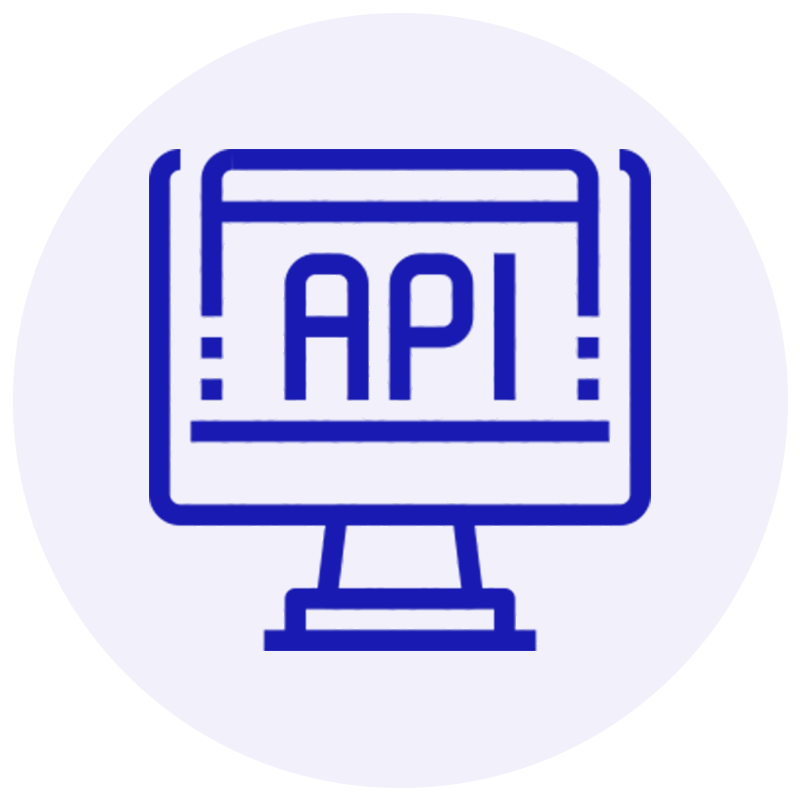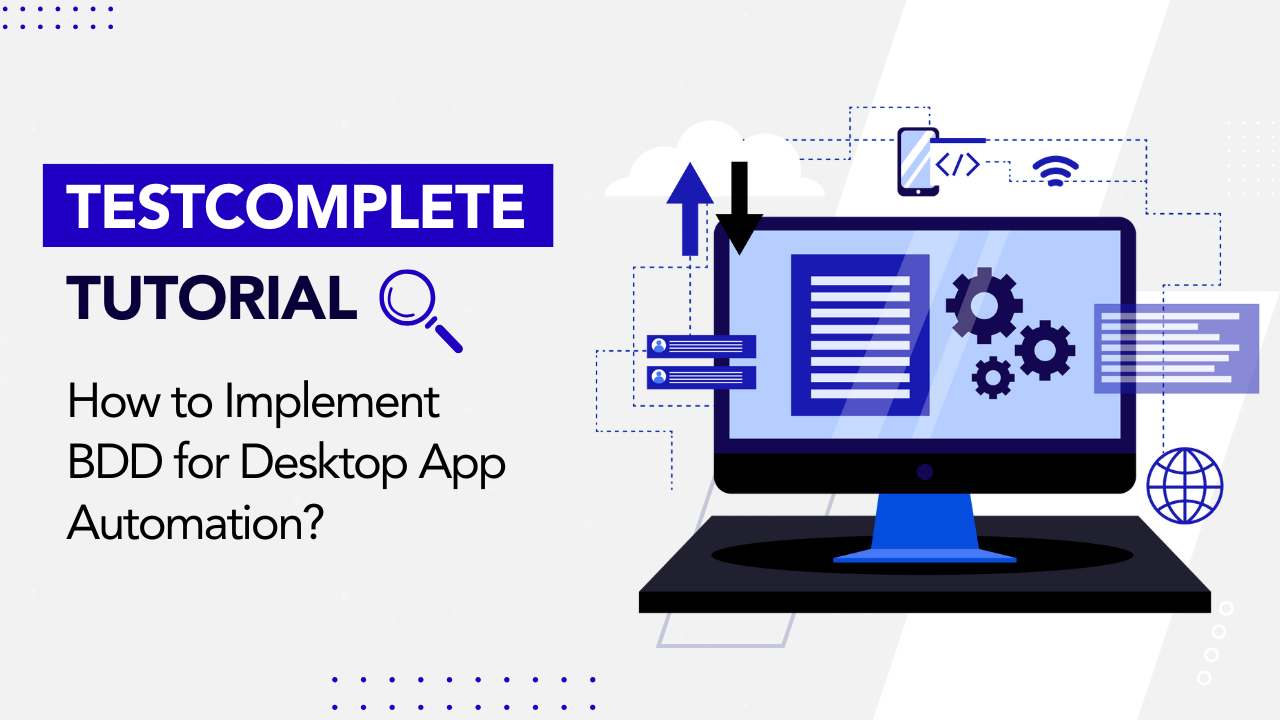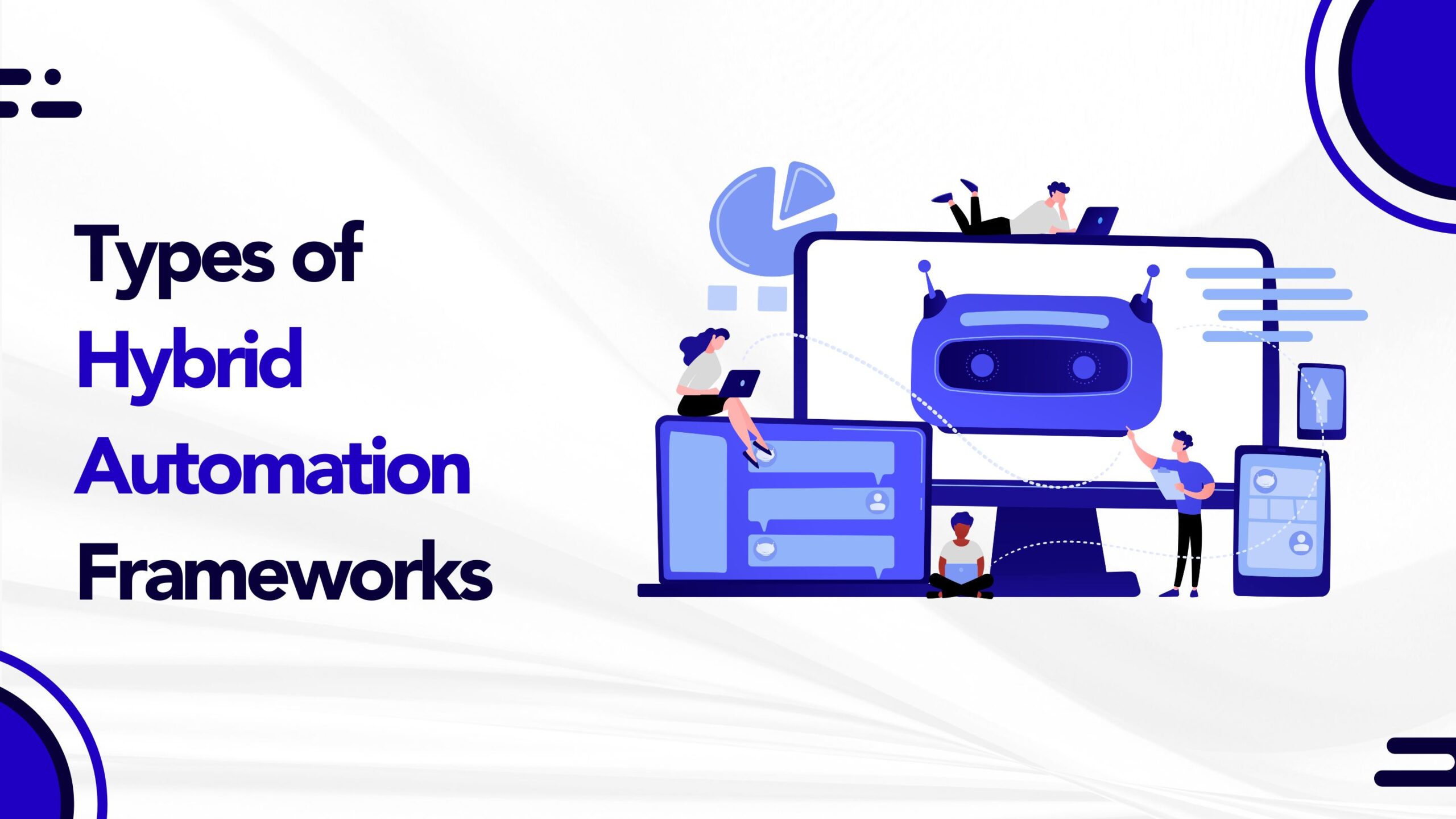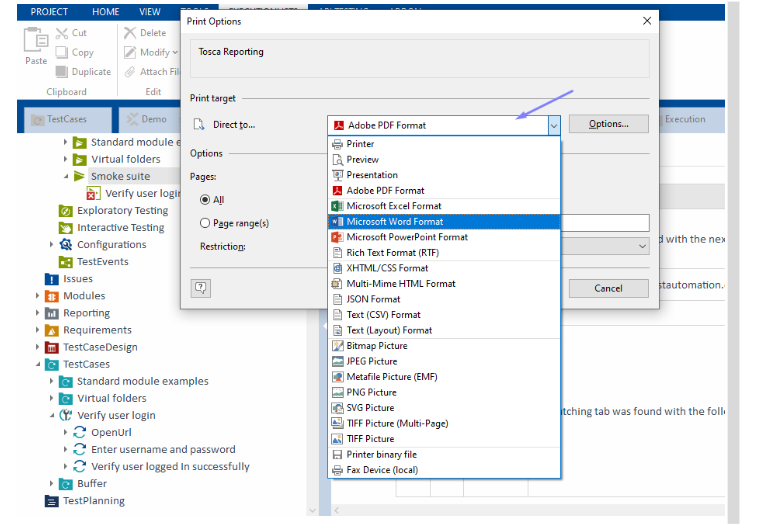
by Charlotte Johnson | Nov 8, 2024 | E-Learning Testing, Blog, Latest Post |
This blog explains why compliance testing is important in eLearning. It shows how compliance testing makes sure your eLearning courses follow industry standards. This testing is essential for a good learning experience for all learners. We will cover the testing process, key tools, and best practices. These points will help you understand more about compliance in eLearning.
Key Highlights
- Compliance testing ensures that eLearning courses meet industry rules and standards.
- It checks if learning management systems (LMS) are user-friendly, efficient, and work well together.
- Some key standards to follow are SCORM, WCAG, and Section 508.
- There are tools to help with the compliance testing process.
- Following best practices helps create a good learning experience for all users.
The Importance of Compliance Testing in eLearning
Compliance testing in eLearning is very important. It does not just go through a checklist. This eLearning Testing makes sure the learning is high-quality and accessible by following all legal rules. When you meet compliance standards, you help everyone access your eLearning content. This includes people with different abilities or disabilities.
Compliance testing makes sure that your content works well with different learning management systems (LMS). This helps you share and spread content easily. When you invest in compliance testing, you show that you care about making a fair and effective learning place for everyone.
Understanding Compliance Standards
Compliance standards in eLearning are rules to follow. They help make sure that online learning content is easy to access, good in quality, and meets the necessary technical needs. These rules are usually made by federal agencies or organizations in various countries.
A popular standard is the Sharable Content Object Reference Model (SCORM). It shows how eLearning content should work with a Learning Management System (LMS). The Web Content Accessibility Guidelines (WCAG) also provide tips on making digital content easier to use for people with disabilities.
It is very important to follow compliance requirements. Doing this helps to create eLearning programs that include everyone and obey the law.
The Role of Compliance in Quality eLearning Content
Compliance is very important for creating good eLearning content. It helps all learners, including those with disabilities, access the learning material. When content creators follow guidelines like WCAG, it becomes easier for everyone to read, use, and understand the information. This way, all learners feel included in the eLearning experience.
Compliance improves the user experience on various LMS platforms. A better experience helps learners focus on the content rather than worry about technical problems. This way, learners can boost their level of understanding and achieve better results in their studies.
Lastly, compliance testing helps improve the quality and trust of eLearning programs. When organizations pay attention to accessibility and follow industry standards, they build a strong reputation. This helps them gain the trust of learners. As a result, learners feel more engaged and satisfied.
Preparing for Compliance Testing: A Beginner’s Guide
Before you look at your eLearning content for compliance, there are several key steps to follow. First, find out about the testing tools and resources that help with eLearning accessibility and SCORM compliance. When you have the right tools and information, it can make the testing process simpler and quicker.
Knowing the best practices for compliance testing in eLearning from the beginning can help you find and solve potential problems early.
Essential Tools and Resources Needed
Having the right tools and resources is important for successful compliance testing in eLearning. Here is what you need:
- Learning Management System (LMS): A good LMS should have tools for compliance testing in eLeanring. It also needs to work well with other testing tools.
- Testing Tools: Use software like SCORM Cloud or Rustici SCORM Test Track. These will help you check if it meets SCORM standards.
- Assistive Technology: Test your content with screen readers like JAWS or NVDA. This ensures it is easy for users who have trouble seeing.
- Color Contrast Analyzer: Make sure there is enough contrast in colors. This is important for people with visual disabilities.
- Usability Testing Tools: Get feedback on how easy your course is to use.
These tools make things easier. They help you find problems and fix them quickly.
Key Considerations Before Starting the Compliance Process
Before you start compliance testing in eLearning, keep these important points in mind:
- Know Your Learner: Learn what your audience needs.
- Some people need useful tools and technology.
Make sure your elearning content matches the LMS you chose. It should work well on different browsers and devices too.
Content Accessibility: Review your content. It has to follow accessibility rules. This means you must add alternative text for images and captions for videos. Also, make sure that people can use it with a keyboard.
Focusing on these things can help people stick to the rules. It can also create a better place for everyone to learn.
Step-by-Step Guide to Effective Compliance Testing in eLearning
Effective compliance testing needs a clear method to be done well. Here is an easy step-by-step guide to make the testing process simpler by following best practices:
Using a clear method can help you do your work better. It also makes it easier to follow the compliance requirements for your eLearning content.
1. Identifying Applicable Compliance Standards
The first step to make sure your eLearning courses follow the rules is to choose the right standards. This choice depends on several things. These things include your industry, your location, and your audience. Here are some common standards:
- SCORM: This helps your course work well with different learning management systems.
- WCAG: This gives rules to make online content easier for people with disabilities.
- Section 508: This is for federal agencies in the U.S. It makes sure their technology is easy to access.
After you find the right standards, read the rules and guidelines closely. This will help you know what you need to change in your eLearning content.
2. Define Compliance Requirements and Objectives
- Find Legal and Regulatory Standards: Look for the laws, industry rules, and company guidelines that apply to the eLearning course. This includes rules about data privacy, such as GDPR, anti-harassment policies, and financial compliance rules.
- Establish Clear Goals: Decide what you want the training to accomplish. This means knowing key topics, demonstrating skills, and completing the training by a specific date. The goals should be clear, measurable, realistic, connected to the topic, and have a deadline (SMART).
3. Conducting a Gap Analysis
Once you find the right compliance standards, do a gap analysis. This means you compare your eLearning content to those standards. It will help you see which parts need to be changed.
Examine aspects such as:
| Feature |
Compliance Requirement |
Status |
Notes |
| Keyboard Navigation |
All functionality accessible via keyboard only. |
Compliant |
– |
| Image Alt Text |
All images have descriptive alternative text. |
Non-Compliant |
Add alt text to images missing descriptions. |
| Video Captions |
All videos have accurate captions. |
Compliant |
– |
| Color Contrast |
Sufficient color contrast between text and background. |
Non-Compliant |
Adjust color schemes to meet contrast ratios |
This analysis shows you a simple way to solve problems. It helps you see which compliance gaps need fixing first.
4. Develop Compliance Test Scenarios
Compliance testing in eLearning ensures that training meets legal and organizational standards. It checks learners’ understanding of key topics and their ability to apply what they’ve learned in real-world situations.
- Use Real Examples: Show real problems workers might face. This makes training feel more useful. For example, when talking about data protection, explain how to handle private information.
- Include Different Question Types: Use several kinds of questions. Include multiple-choice, case studies, practice tests, and open-ended questions. This checks what people know and how they can use that knowledge.
- Stay on Learning Goals: Make sure each question and example connects to your learning goals. If one goal is to understand workplace discrimination, give examples where someone sees unfair actions.
5. Design Effective Testing Mechanisms
- Choose Test Types: Use practice tests, quizzes, and final exams. They help check how well students understand the material. Practice tests show what students know. Final exams measure their overall skills.
- Use Random Questions: To keep tests fair and reduce cheating, use different questions for each student. This works well for larger groups.
- Try Adaptive Testing: In some subjects, adaptive testing changes the difficulty based on earlier answers. This helps see students’ strengths and weaknesses better.
6. Ensure User Accessibility and Compatibility
In Compliance Testing in eLearning, it’s crucial to ensure that training content is accessible to all learners and compatible with different platforms. This involves checking accessibility standards and verifying the content works seamlessly across various devices and browsers.
- Test for Accessibility Standards: Check if the content follows accessibility rules like WCAG. This includes adding captions for videos, making text easy for screen readers, and using simple designs. Everyone should be able to navigate through it.
- Verify Platform Compatibility: Test the content on various devices, such as desktops, tablets, and smartphones. Also, check it on several web browsers. This ensures that everyone can access the compliance training without any problems. It should be easy for all employees to use.
7. Conduct Beta Testing
- Get a Pilot Group: Test your program with a small group that reflects your larger audience. Pick people from different jobs to get different views.
- Collect Feedback: Ask them for their opinions on how clear, useful, and tough the test is. Their feedback will help you find parts that need fixing, like hard words or missing details.
- Look at Completion Rates and Scores: Keep track of how many people complete the course and their scores. This will show how well it is working at first. A lot of failures might mean the material needs to be clearer or more connected to real-life examples.
8. Evaluate Test Results and Adjust as Needed
- Check Question Data: Review how everyone answered each question. This helps find any issues. If a lot of people get a question wrong, revisit the related material.
- Change Based on Data: Use the pass and fail rates, the time spent on questions, and any feedback to make the course or test better. Look for patterns that show which topics need more attention.
9. Implement Regular Updates and Reviews
- Schedule Regular Updates: Compliance requirements often change. It is important to check the content and questions on a regular basis. This will help keep everything updated.
- Incorporate Feedback Loops: After each compliance period, get feedback from participants and assessors. This will help improve the training. Regular updates will keep the material relevant and interesting.
10. Maintain Documentation and Reporting
- Create Reports: Track how many people join, how long it takes them to finish, and how well they perform. This helps show stakeholders and regulatory groups that you meet compliance rules.
- Record Completion: Save each person’s completion and scores as proof of compliance. Many companies use a Learning Management System (LMS) for easy access to this information.
- Set Up a Certification Process: If needed, provide completion certificates. This gives official proof that employees finished the required training.
11. Optimize for Ongoing Improvement
- Set Benchmarks and KPIs: Watch important numbers like test completion rates, average scores, and knowledge retention. These numbers can show how effective the compliance training is as time goes on.
- Conduct Post-Training Assessments: After some time, give quizzes or tests. This will help remind employees of key points and check their memory. It ensures that employees continue to understand compliance topics.
12. Foster a Compliance Culture
- Encourage Open Discussions: Make it easy for employees to feel safe when they ask questions and talk about different topics. This helps create a culture that follows the rules. A forum or a Q&A section in the module can assist with this.
- Provide Resources for Further Learning: Give employees extra materials to help them learn more about compliance. This could include links to official rules, legal updates, and other important information.
Conclusion
Compliance testing in eLearning is very important. It helps you meet industry standards. When you follow these compliance requirements, your eLearning content becomes better. To succeed, you need to find the right standards to aim for. A thorough gap analysis can help too. Using good tools will support you in compliance testing. A clear step-by-step guide will simplify the process. This way, your eLearning materials will be more compliant. Keep yourself updated on common compliance standards in eLearning. This practice will help you stay trusted in the industry. Think of compliance testing as the key to providing high-quality eLearning experiences.
Frequently Asked Questions
-
What are the most common compliance standards in eLearning?
The main rules for eLearning that we need to follow are SCORM, WCAG, and Section 508. SCORM helps eLearning courses work well with Learning Management Systems (LMS). WCAG makes sure the web is easy to access for everyone. Section 508 is important for federal agencies in the U.S. These rules help all people use eLearning without any trouble. They ensure that the content works well with tools like screen readers. They also provide captions for audio and video.

by Anika Chakraborty | Nov 7, 2024 | Automation Testing, Blog, Recent, Latest Post |
In today’s world of finance, mobile applications for test trading software are essential tools for users who need quick access to real-time data and market analysis within a reliable Electronic trading platform, including algorithmic trading capabilities, alongside vast amounts of data for portfolio management tools. As more investors, traders, and researchers rely on these apps for making informed decisions, the demand for a smooth, reliable, and fast experience grows, reflecting a continuous increase in the volume of trades and user expectations. Testing these complex, data-heavy applications and their interfaces for stability and accuracy is a challenging task, especially given frequent updates and high user expectations.
To meet this demand, automated software testing is an ideal solution. This blog will walk you through the key types of automated testing for mobile applications, focusing on functional testing, parallel testing, regression testing, and release support testing. We’ll also discuss how we used Appium, Java, and TestNG to streamline the software testing process, with the help of Extent Reports for detailed and actionable test results, drawing upon our years of experience in the industry.
Why Automate Testing for Trading Software?
Testing a financial app manually is time-consuming and can be prone to human error, especially when dealing with frequent updates. Automation helps in achieving quicker and more consistent test results, making it possible to identify issues early and ensure a smooth user experience across various devices.
In our case, automation allowed us to achieve:
- Faster Testing Cycles: By automating repetitive test cases, we were able to execute tests more quickly, allowing for rapid feedback on app performance.
- Increased Test Coverage: Automation enabled us to test a wide range of scenarios and device types, ensuring comprehensive app functionality.
- Consistent and Reliable Results: Automated tests run the same way every time, eliminating variability and minimizing the risk of missed issues.
- Early Bug Detection: By running automated tests frequently, bugs and issues are caught earlier in the development cycle, reducing the time and cost of fixes.
Tools and Frameworks:
To create a robust automated testing suite, we chose:
- Appium: This open-source tool is widely used for mobile app testing and supports both Android and iOS, making it flexible for testing cross-platform apps. Appium also integrates well with many other tools, allowing for versatile test scenarios.
- Java: As a powerful programming language, Java is widely supported by Appium and TestNG, making it easy to write readable and maintainable test scripts.
- TestNG: This testing framework is ideal for organizing test cases, managing dependencies, and generating reports. It also supports parallel test execution, which greatly reduces testing time.
This combination of tools allowed us to run detailed, reliable tests on our app’s functionality across a variety of devices, ensuring stability and performance under various conditions.
Essential Automated Testing Strategies
Given the complexity of our financial app, we focused on four primary types of automated testing to ensure full coverage and high performance: functional testing, parallel testing, regression testing, and release support testing.
1. Functional Testing
Functional testing ensures that each feature within the app works as intended. Financial applications have many interactive modules, such as market movers, portfolio trackers, and economic calendars, all of which need to perform correctly for users to make informed decisions.
For functional testing:
- We designed test cases for every major feature, such as alerts, notifications, portfolio performance, and economic calendar updates.
- Each test case was crafted to simulate real-world usage—like adding stocks to a watchlist, setting price alerts, or viewing market data updates.
- Our tests validated both individual functions and integrations with other features to ensure smooth navigation and information accuracy.
Functional testing through automation made it easy to rerun these tests after updates, confirming that each feature continued to work seamlessly with others, and gave us peace of mind that core functionality was stable.
2. Parallel Testing
Parallel testing is the practice of running tests on multiple devices simultaneously, ensuring consistent user experience across different screen sizes, operating system versions, and hardware capabilities. This is especially important for financial apps, as users access them on a wide variety of devices, from high-end to budget models.
Using Appium’s parallel testing capability, we could:
- Execute the same tests on multiple devices to check for performance or layout differences.
- Ensure UI elements are scaled correctly across screen sizes and resolutions, so users have a similar experience no matter what device they use.
- Measure the app’s speed and stability on low-spec and high-spec devices, ensuring it worked well even with slower hardware.
Parallel testing allowed us to identify issues that might only occur on certain devices, providing a consistent experience for all users regardless of device type.
3. Regression Testing
Financial apps often require frequent updates to add new features, integrate new data sources, or improve user experience. With every update, there’s a risk of inadvertently disrupting existing functionality, making regression testing essential.
Regression testing confirms that new code does not interfere with previously working features. We used automated tests to:
- Run tests on all core functionalities after each update, ensuring that previously verified features continue to work.
- Include a comprehensive set of test cases for all major modules like watchlists, market alerts, and data feeds.
- Quickly identify and address any issues introduced by new code, reducing the need for lengthy manual testing.
By running automated regression tests with each update, we could confirm that the app retained its stability, functionality, and performance while incorporating new features.
4. Release Support Testing
As part of the release process, release support testing provides a final layer of validation before an app is published or updated in the app store. This testing phase involves a combination of smoke testing and integration testing to confirm that the application is ready for end-users.
In release support testing, we focused on:
- Testing critical functions to ensure there were no blocking issues that could impact user experience.
- Performing sanity checks on newly added or modified features, ensuring they integrate smoothly with the app’s existing modules.
This final step was essential for giving both the development team and stakeholders confidence that the app was ready for public release, free from critical bugs, and aligned with user expectations.
5. API Testing
APIs are the backbone of trading apps, connecting them with data feeds, analytics, and execution services. Testing APIs thoroughly ensures they’re fast, accurate, and secure.
- Data Accuracy Checks: Verifies that APIs return accurate and up-to-date information, especially for real-time data like prices and news.
- Response Time Validation: Tests the speed of APIs to ensure low latency, which is critical in time-sensitive trading environments.
- Security and Error Handling: Ensures APIs are secure and handle errors effectively to protect user data and maintain functionality.
6. Performance Testing
Performance testing is vital to ensure trading software performs reliably, even during high-volume periods like market openings or volatility spikes.
- Load Testing: Verifies that the app can handle a high number of simultaneous users without slowing down.
- Stress Testing: Pushes the app to its limits to identify any breaking points, ensuring stability under extreme conditions.
- Scalability Assessment: Ensures that the app can scale as the user base grows without impacting performance.
Reporting and Results with Extent Reports
A critical component of automated testing is reporting. Extent Reports, a rich and detailed reporting tool, provided us with insights into each test run, allowing us to easily identify areas that needed attention.
With Extent Reports, we were able to:
- View detailed reports for each test—including screenshots of any failures, test logs, and performance metrics.
- Share results with stakeholders, making it easy for them to understand test outcomes, even if they don’t have a technical background.
- Identify trends in test performance over time, allowing us to focus on areas where issues were frequently detected.
The reports were visually rich, actionable, and essential in helping us communicate testing progress and outcomes effectively with the wider team.
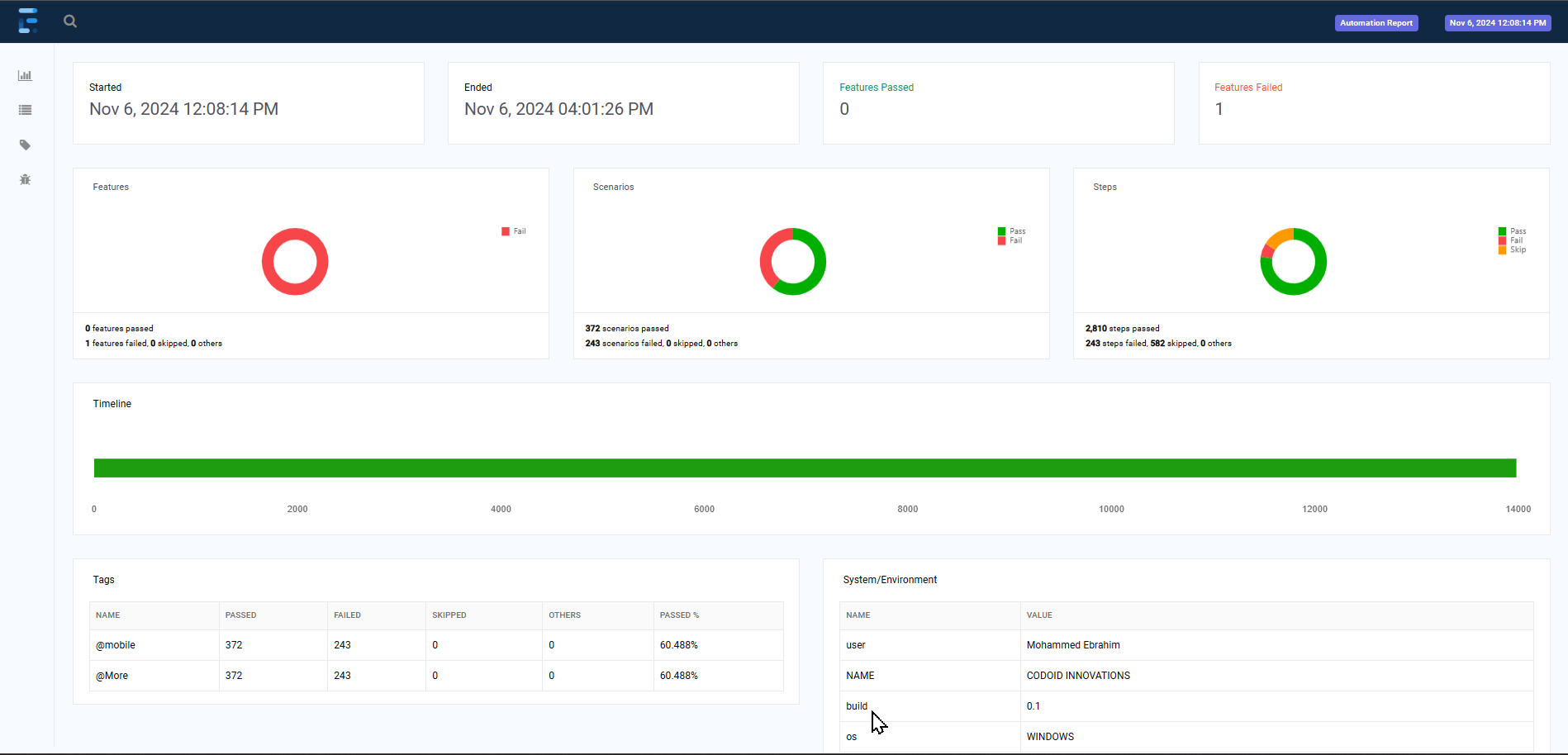
Key Benefits of Automated Testing for Financial Apps
Implementing automated testing for our financial app provided numerous advantages:
- Efficiency and Speed: Automated testing significantly reduced the time required for each test cycle, allowing us to perform more tests in less time.
- Expanded Test Coverage: Automated tests allowed us to test a wide range of scenarios and interactions, ensuring a reliable experience across multiple device types.
- Consistency and Accuracy: By removing human error, automation enabled us to run tests consistently and with high accuracy, yielding reliable results.
- Reduced Costs: By identifying bugs earlier in the development cycle, we saved time and resources that would have otherwise been spent on fixing issues post-release.
- Enhanced Stability and Quality: Automation gave us confidence that each release met high standards for stability and performance, enhancing user trust and satisfaction.
Conclusion
Automating mobile app testing is essential in today’s competitive market, especially for data-driven applications that users rely on to make critical decisions. By using Appium, Java, and TestNG, we could ensure that our app delivered a reliable, consistent experience across all devices, meeting the demands of a diverse user base.
Through functional testing, parallel testing, regression testing, and release support testing, automated testing enabled us to meet high standards for quality and performance. Extent Reports enhanced our process by providing comprehensive and understandable test results, making it easier to act on insights and improve the app with each update.
Beyond being a time-saver, automation elevates the quality and reliability of mobile app testing, making it an essential investment for teams developing complex, feature-rich applications. Codoid delivers unparalleled expertise in these testing methodologies explore our case study for an in-depth view of our approach and impact.

by Chris Adams | Nov 6, 2024 | Artificial Intelligence, Blog, Recent, Latest Post |
AI coding assistants like Cursor AI and GitHub Copilot are changing the way we create software. These powerful tools help developers write better code by providing advanced code completion and intelligent suggestions. In this comparison, we’ll take a closer look at what each tool offers, along with their strengths and weaknesses. By understanding the differences between Cursor AI vs. Copilot, this guide will help developers choose the best option for their specific needs
Key Highlights
- Cursor AI and GitHub Copilot are top AI tools that make software development easier.
- This review looks at their unique features, strengths, and weaknesses. It helps developers choose wisely.
- Cursor AI is good at understanding entire projects. It can be customized to match your coding style and workflow.
- GitHub Copilot is great for working with multiple programming languages. It benefits from using GitHub’s large codebase.
- Both tools have free and paid options. They work well for individual developers and team businesses.
- Choosing the right tool depends on your specific needs, development setup, and budget.
A Closer Look at Cursor AI and GitHub Copilot
In the changing world of AI coding tools, Cursor AI and GitHub Copilot are important. Both of these tools make coding faster and simpler. They give smart code suggestions and automate simple tasks. This helps developers spend more time on harder problems.
They use different ways and special features. These features match the needs and styles of different developers. Let’s look closely at each tool. We will see what they can do. We will also see how they compare in several areas.
Overview of Cursor AI Features and Capabilities
Cursor AI is unique because it looks at the whole codebase. It also adjusts to the way each developer works. It does more than just basic code completion. Instead, it gives helpful suggestions based on the project structure and coding styles. This tool keeps improving to better support developers.
One wonderful thing about Cursor AI is the special AI pane, designed with simplicity in mind. This pane lets users chat with the AI assistant right in the code editor. Developers can ask questions about their code. They can also get help with specific tasks. Plus, they can make entire code blocks just by describing them in natural language.
Cursor AI can work with many languages. It supports popular ones like JavaScript, Python, Java, and C#. While it does not cover as many less-common languages as GitHub Copilot, it is very knowledgeable about the languages it does support. This allows it to give better and more precise suggestions for your coding projects.
Overview of GitHub Copilot Features and Capabilities
GitHub Copilot is special because it teams up with GitHub and supports many programming languages. OpenAI helped to create it. Copilot uses a large amount of code on GitHub to give helpful code suggestions right in the developer’s workflow.
Users of Visual Studio Code on macOS enjoy how easy it is to code. This tool fits well with their setup. It gives code suggestions in real-time. It can also auto-complete text. Additionally, it can build entire functions based on what the developer is doing. This makes coding easier and helps developers stay focused without switching tools.
GitHub Copilot is not just for Visual Studio Code. It also works well with other development tools, like Visual Studio, JetBrains IDEs, and Neovim. The aim is to help developers on different platforms while using GitHub’s useful information.
Key Differences Between Cursor AI and GitHub Copilot
Cursor AI and GitHub Copilot both help make coding easier with AI, but they do so in different ways. Cursor AI looks at each project one at a time. It learns how the developer codes and gets better at helping as time goes on. GitHub Copilot, backed by Microsoft, is tied closely to GitHub. It gives many code suggestions from a large set of open-source code.
These differences help us see what each tool is good at and when to use them. Developers need to know this information. It helps them pick the right tool for their workflow, coding style, and project needs.
Approach to Code Completion
Cursor AI and GitHub Copilot assist with completing code, but they work differently. Each has its advantages. Cursor AI focuses on giving accurate help for a specific project. It looks at the whole codebase and learns the developer’s style along with the project’s rules. This helps it suggest better code, making it a better choice for developers looking for tailored assistance.
GitHub Copilot has a broad view. It uses a large database of code from different programming languages. This helps it to provide many suggestions. You can find it useful for checking out new libraries or functions that you are not familiar with. However, sometimes its guidance may not be very detailed or suitable for your situation.
Here’s a summary of their methods:
Cursor AI:
- Aims to be accurate and relevant in the project.
- Knows coding styles and project rules.
- Good at understanding and suggesting code for the project.
GitHub Copilot:
- Gives more code suggestions.
- Uses data from GitHub’s large code library.
- Helps you explore new libraries and functions.
Integration with Development Environments
A developer’s connection with their favorite tools is key for easy use. Cursor AI and GitHub Copilot have made efforts to blend into popular development environments. But they go about it in different ways.
Cursor AI aims to create an easy and connected experience. To do this, they chose to build their own IDE, which is a fork of Visual Studio Code. This decision allows them to have better control and to customize AI features right within the development environment. This way, it makes the workflow feel smooth.
GitHub Copilot works with different IDEs using a plugin method. It easily connects with tools like Visual Studio, Visual Studio Code, Neovim, and several JetBrains IDEs. This variety makes it usable for many developers with different IDEs. However, the way it connects might be different for each tool.
| Feature |
Cursor AI |
GitHub Copilot |
| Primary IDE |
Dedicated IDE (fork of VS Code) |
Plugin-based (VS Code, Visual Studio, others) |
| Integration Approach |
Deep, native integration |
Plugin-based, varying levels of integration |
The Strengths of Cursor AI
Cursor AI is a strong tool for developers. It works as a flexible AI coding assistant. It can adapt to each developer’s coding style and project rules. This helps in giving better and more useful code suggestions.
Cursor AI does more than just finish code. It gets the entire project. This helps in organizing code, fixing errors, and creating large parts of code from simple descriptions in natural language. It is really useful for developers who work on difficult projects. They need a strong grasp of the code and smooth workflows.
Unique Selling Points of Cursor AI
Cursor AI stands out from other options because it offers unique features. These features are made to help meet the specific needs of developers.
Cursor AI is special because it can see and understand the whole codebase, not just a single file. This deep understanding helps it offer better suggestions. It can also handle changes that involve multiple files and modules.
Adaptive Learning: Unlike other AI tools that just offer general advice, Cursor AI learns your coding style. It understands the rules of your project. As a result, it provides you with accurate and personalized help that matches your specific needs.
Cursor AI helps you get things done easily. It uses its own IDE, which is similar to Visual Studio Code. This setup ensures that features like code completion, code generation, and debugging work well together. This way, you can be more productive and have fewer interruptions.
Use Cases Where Cursor AI Excels
Cursor AI is a useful AI coding assistant in several ways:
- Large-Scale Projects: When dealing with large code and complex projects, Cursor AI can read and understand the whole codebase. Its suggestions are often accurate and useful. This reduces mistakes and saves time when fixing issues.
- Team Environments: In team coding settings where everyone must keep a similar style, Cursor AI works great. It learns how the team functions and helps maintain code consistency. This makes the code clearer and easier to read.
- Refactoring and Code Modernization: Cursor AI has a strong grasp of code. It is good for enhancing and updating old code. It can recommend better writing practices, assist in moving to new frameworks, and take care of boring tasks. This lets developers focus on important design choices.
The Advantages of GitHub Copilot
GitHub Copilot is special. It works as an AI helper for people who code. It gives smart code suggestions, which speeds up the coding process. Its main power comes from the huge amount of code on GitHub. This helps it support many programming languages and different coding styles.
GitHub Copilot is unique because it gives developers access to a lot of knowledge across various IDEs. This is great for those who want to try new programming languages, libraries, or frameworks. It provides many code examples and ways to use them, which is very helpful. Since it can make code snippets quickly and suggest different methods, it helps users learn and explore new ideas faster.
GitHub Copilot’s Standout Features
GitHub Copilot offers many important features. These make it a valuable tool for AI coding help.
- Wide Language Support: GitHub Copilot accesses a large code library from GitHub. It helps with many programming languages. This includes popular ones and some that are less known. This makes it a useful tool for developers working with different technology.
- Easy Integration with GitHub: As part of the GitHub platform, Copilot works smoothly with GitHub repositories. It offers suggestions that match the context. It examines project files and follows best practices from those files, which makes coding simpler.
- Turning Natural Language Into Code: A cool feature of Copilot is that it can turn plain language into code. Developers can explain what they want to do, and Copilot can suggest or generate code that matches their ideas. This helps connect what people mean with real coding.
Scenarios Where GitHub Copilot Shines
GitHub Copilot works really well where it can use its language support. It can write code and link to GitHub with ease.
Rapid Prototyping and Experimentation: When trying out new ideas or making quick models, GH Copilot can turn natural language descriptions into code. This helps developers work faster and test different methods easily.
Learning New Technologies: If you are a developer who uses new languages or frameworks, GitHub Copilot is very helpful. It has a lot of knowledge. It can suggest code examples. These examples help users to understand syntax and learn about libraries. This helps make learning faster.
Copilot may not check codebases as thoroughly as Cursor AI. Still, it helps improve code quality. It gives helpful code snippets and encourages good practices. This way, developers can write cleaner code and have fewer errors.
Pricing
Both Cursor AI and GitHub Copilot provide various pricing plans for users. GitHub Copilot uses a simple subscription model. You can use its features by paying a monthly or yearly fee. There is no free option, but the cost is fair. It provides good value for developers looking to improve their workflow with AI.
Cursor AI offers different pricing plans. There is a free plan, but it has some limited features. For more advanced options, you can choose from the professional and business plans. This allows individual developers to try Cursor AI for free. Teams can also choose flexible options to meet larger needs.
Pros and Cons
Both tools are good for developers. Each one has its own strengths and weaknesses. It is important to understand these differences. This will help you make a wise choice based on your needs and preferences for the project.
Let’s look at the good and bad points of every AI coding assistant. This will help us see what they are good at and where they may fall short. It will also help developers choose the AI tool that fits their specific needs.
Cursor Pros:
- Understanding Your Codebase: Cursor AI is special because it can read and understand your entire codebase. This allows it to give smarter suggestions. It does more than just finish your code; it checks the details of how your project is laid out.
- Personalized Suggestions: While you code, Cursor AI pays attention to how you write. It adjusts its suggestions to fit your style better. As time goes on, you will get help that feels more personal, since it learns what you like and adapts to your coding method.
- Enhanced IDE Experience: Cursor AI has its own unique IDE, based on Visual Studio Code. This gives you a smooth and complete experience. It’s easy to access great features, like code completion and changing your whole project, in a space you already know. This helps cut down on distractions and makes your work better.
Cursor Cons:
- Limited IDE Integration (Only Its Own): Cursor AI works well in its own build. However, it does not connect easily with other popular IDEs. Developers who like using different IDEs may have a few problems. They might not enjoy the same smooth experience and could face issues with compatibility.
- Possible Learning Curve for New Users: Moving to a new IDE, even if it seems a bit like Visual Studio Code, can be tough. Developers used to other IDEs might need time to get used to the Cursor AI workflow and learn how to use its features well.
- Reliance on Cursor AI’s IDE: While Cursor AI’s own IDE gives an easy experience, it also means developers need to depend on it. Those who know other IDEs or have special project needs may see this as a problem.
GitHub Copilot Pros:
- Language Support: GitHub Copilot supports many programming languages. It pulls from a large set of code on GitHub. It offers more help than many other tools.
- Easy Plugin Integration: GitHub Copilot works great with popular platforms like Visual Studio Code. It has a simple plugin that is easy to use. This helps developers keep their normal workflow while using Copilot.
- Turning Natural Language Into Code: A great feature of Copilot is its skill in turning natural language into code. Developers can describe what they want easily. They can share their ideas, and Copilot will give them code suggestions that fit their needs.
GitHub Copilot Cons:
GitHub Copilot has a large codebase. Sometimes, its suggestions can be too broad. It may provide code snippets that are correct, but they do not always fit your project. This means developers might have to check and change the code it suggests.
Copilot works with GitHub and can look at project folders. However, it doesn’t fully understand the coding styles in your project. This can lead to suggestions that don’t match your team’s standards. Because of this, you may need to put more effort into keeping everything consistent.
There is a risk of depending too much on Copilot. This can result in not fully understanding the code. Although Copilot can be helpful, if you only follow its suggestions without learning the key concepts, it will leave gaps in your knowledge. These gaps can make it harder to tackle difficult problems later on.
Conclusion
In conclusion, by examining Cursor AI and GitHub Copilot, we gain valuable insights into their features and how developers can use them effectively. Each tool has its own strengths—Cursor AI performs well for certain tasks, while GitHub Copilot excels in other areas. Understanding the main differences between these tools allows developers to select the one that best suits their needs and preferences, whether they prioritize code completion quality, integration with their development environment, or unique features.
For developers looking to go beyond standard tools, Codoid provides best-in-class AI services to further enhance the coding and development experience. Exploring these advanced AI solutions, including Codoid’s offerings, can take your coding capabilities to the next level and significantly boost productivity.
Frequently Asked Questions
-
Which tool is more user-friendly for beginners?
For beginners, GitHub Copilot is simple to use. It works well with popular tools like Visual Studio Code. This makes it feel familiar and helps you learn better. Cursor AI is strong, but you have to get used to its own IDE. This can be tough for new developers.
-
Can either tool be integrated with any IDE?
GitHub Copilot can work with several IDEs because of its plugin. It supports many platforms and is not just for Visual Studio Code. In contrast, Cursor AI mainly works in its own IDE, which is built on VS Code. It may have some limits when trying to connect with other IDEs.
-
How do the pricing models of Cursor AI and GitHub Copilot compare?
Cursor AI has a free plan, but it has limited features. On the other hand, GitHub Copilot needs payment for its subscription. Both services offer paid plans that have better features for software development. Still, Cursor AI has more flexible choices in its plans.
-
Which tool offers better support for collaborative projects?
Cursor AI helps teams work together on projects. It understands code very well. It can adjust to the coding styles your team uses. This helps to keep things consistent. It also makes it easier to collaborate in a development environment.

by Chris Adams | Nov 5, 2024 | Game Testing, Blog, Recent, Latest Post |
In today’s gaming world, giving players a great experience is very important. Game testing is a key part of making sure video games are high quality and work well. It helps find and fix bugs, glitches, and performance issues. The goal is to ensure players have a fun and smooth time. This article looks at some special challenges in game testing and offers smart ways to deal with them.
Key Highlights
- Game testing is key for finding bugs, making gameplay better, and improving user experience.
- Testing on different platforms and managing unexpected bugs while meeting tight deadlines can be tough.
- Mobile game testing faces specific challenges due to different devices, changing networks, and the need for performance upgrades.
- AI and automation help make testing easier and more efficient.
- Good communication, flexible methods, and focusing on user experience are vital for successful game testing.
What are the common challenges faced by game testers?
Game testers often encounter challenges like game-breaking bugs, tight deadlines, repetitive testing tasks, and communication issues with developers. Finding and fixing elusive bugs, coordinating testing schedules, and balancing quality assurance with time constraints are common hurdles in game testing.
Identifying Common Challenges in Game Testing
Game testing has its own special challenges. These are different from those found in regular software testing. Games are fun and interactive, so they require smart testing approaches. It’s also important to understand game mechanics well. Game testers face many issues. They have to handle complex game worlds and check that everything works on different platforms.
Today’s games are more complicated. They have better graphics, let players join multiplayer matches, and include AI features. This makes testing them a lot harder. Let’s look at these challenges closely.
The Complexity of Testing Across Multiple Platforms
The gaming industry is growing on consoles, PCs, mobile devices, and in the cloud. This growth brings a big challenge to ensure good game performance across all platforms. Each platform has its own hardware and software. They also have different ways for users to play games. Because of this, game developers must test everything carefully to ensure it all works well together.
Testing must look at various screen sizes, resolutions, and performance levels. Testers also need to think about different operating systems, browsers, and network connections. Because of this, game testers use several methods. They mainly focus on performance testing and compatibility testing to handle these challenges.
Handling the Unpredictability of Game Bugs and Glitches
Game bugs and glitches can show up suddenly. This is because the game’s code, graphics, and player actions work in a complex way. Some problems are small, like minor graphic flaws. Others can be serious, like crashes that completely freeze the game. These issues can make players feel frustrated and lead to a poor gaming experience.
The hard part is finding, fixing, and keeping an eye on these problems. Game testers usually explore, listen to player feedback, and use special tools to find and report bugs. It is important to work with the development team to fix bugs quickly and ensure a good quality.
Mobile Game Testing Challenges
The mobile gaming market has expanded rapidly in the last few years. This rise has created good opportunities and some challenges for game testers. Millions of players enjoy games on different mobile devices. To keep their gaming experience smooth and enjoyable, mobile game testing and mobile application testing are very important. Still, this field has its own issues.
Mobile game testing has several challenges. First, there are many different devices to consider and limits with their networks. Next, performance and security issues are also very important. Testing mobile games requires special skills and careful planning. This helps to make sure the games are of high quality. Let’s look at some key challenges in mobile game testing.
Inadequate Expertise
Mobile game testing requires different skills than regular software testing. Testers need to understand mobile platforms and different devices. They also have to learn how to simulate networks. Knowing the tools made for mobile game testing is important too. There aren’t many skilled testers for mobile games, which can lead to problems for companies.
It’s key to hire people who know about game testing. You can also teach your current team about mobile game testing methods and tools. They should learn about audio testing too. Testers need several mobile devices for their jobs. They must understand how to check mobile issues like battery use, performance problems, and how the touch screen responds. This knowledge is very important for good mobile game testing.
Difficulty in Simulating All Real-World Cases
Game testing has a major challenge. It is tough to recreate all the real situations players might face. Different devices give different user experiences which makes testing harder. Mobile games need to work well on several specifications. We need manual testing to check how the game mechanics, multiplayer functions, and servers act in different conditions. This process needs extra focus. The success of a game relies on fixing these issues to provide a great gaming experience. Using test automation scripts is very important. These scripts help cover many situations and keep the quality high for the target audience.
Complexity of Game Mechanics and Systems:
Connections Between Features: Games are made of systems that work together. Physics, AI, rendering, and sound all connect. A change in one part can change another. This may cause bugs that are tough to find and fix.
Multiplayer and Online Parts: When testing features that include many players, it is important to ensure everyone has the same experience. This should happen no matter the device or internet speed. It can lead to problems like lag, server issues, and matchmaking problems.
Randomness and Created Content: Many games have random elements, like treasure drops or level design. This makes it hard to test every situation completely.
Platform Diversity:
Cross-Platform Challenges: Games often release on several platforms like PC, consoles, and mobile. Testing must look at each platform’s special features. This means checking hardware limits, input styles, and operating systems.
Hardware and Software Differences on PC: PCs have many kinds of hardware, including various GPUs, CPUs, and driver versions. Ensuring everything works together can be difficult.
Input Methods: Games that accept different input methods, like controllers, keyboard/mouse, and touch, need testing. This is to ensure all controls work well together and feel consistent.
User Experience and Accessibility Testing
- Gameplay Balancing: Making a game fun and fair for all can be tricky. It takes understanding the various ways people play and their skills.
- Accessibility: Games should be easy for everyone, including those with disabilities. This means checking options like colorblind modes, controls, and screen reader support.
- User Satisfaction: Figuring out how fun a game is can be difficult. What one person enjoys, another may not. It can be hard to find clear ways to measure different fun experiences.
Testing Open Worlds and Large-Scale Games
- Large World Sizes: Open-world games have big maps, different places, and player actions that can be surprising. This makes it hard to check everything quickly.
- Exploit and Boundary Testing: In open-world games, players enjoy testing limits or using features in new ways. Testers need to find these issues or places where players could create problems.
- Changing Events and Day/Night Cycles: Games with changing events, time cycles, or weather need good testing. This helps ensure all features work well in any situation.
Non-Deterministic Bugs and Issues with Reproducibility
- Bugs That Appear Sometimes: Some bugs only happen in specific situations that are not common, like certain player moves or special input combos. This makes them tough to fix.
- Timing Issues: In multiplayer games, bugs can occur because of timing gaps between player actions and the server’s response. These problems can be hard to find and solve because they depend on random timing.
- Random Content: In games with random levels, bugs may only appear in certain setups. This makes it difficult to reproduce these issues every time.
High Performance Demands
- Frame Rate and Optimization Issues: Games need a steady frame rate. This requires testing on different hardware. A fall in performance can ruin gameplay, especially in fast-paced games.
- Memory and Resource Management: Games use many resources. Memory leaks or poor management can lead to crashes, stutters, or slow performance over time, especially on weaker devices.
- Visual Quality and Graphical Bugs: Games should look good without affecting performance. This requires careful testing to find any graphical problems, glitches, or texture loading issues.
Frequent Updates and DLCs
- Post-Launch Updates and Patches: Ongoing updates provide new features or fixes. But they can also introduce new bugs. This makes it important to test current content to keep everything stable.
- Compatibility with Previous Versions: Each update must work well with older versions and have no issues in any downloadable content (DLC). This means more work for testers.
- Player Feedback and Community Expectations: After the launch, developers receive direct feedback from players. They often want quick fixes. It can be hard to balance these requests with careful testing and quick replies.
Realistic Testing Environments
- Simulating Player Behavior: Testers should think like players. They must consider how users might play the game in surprising ways. This includes rare moments, cheats, or different styles that can create issues.
- Network and Server Stress Testing: Testing multiplayer games should copy heavy server use and network issues. This helps see how well the game can handle real-life pressure. It checks server strength, stability, and keeps data organized.
- Difficulty in Real-Time Testing: Some bugs only appear when real players are playing. This can make it tough to find problems before launch without having large play tests.
Resource and Time Constraints
- Time Pressures from Tight Deadlines: Game development usually has tight release dates. This creates great pressure on teams to find and fix as many bugs as possible in a short time.
- Balancing Testing Depth and Speed: Testers have to find a middle ground. They must test some areas well while also looking at the whole game fast. This is tough when the game is complex and needs deep testing.
- Limited Testing Resources: Testing tools like devices, money, and staff are often small. This makes it hard to check every part of the game.
Subjective Nature of Fun and Player Enjoyment
- Testing for Fun and Engagement: It is very important to test games to see if they are enjoyable. This is different from other software, which has a specific purpose. Games must be tested to see if they feel fun, engaging, and rewarding. Each player can feel differently about this.
- Community and Social Dynamics: For multiplayer or social games, testing should look at how players connect with each other. It needs to ensure that features like chat, events in the game, and social choices provide a good and fair experience for everyone.
Strategies for Efficient Game Testing
To handle the challenges in game testing, it is important to use strategies that make the process better. This will help increase test coverage and ensure that high-quality games are released. By using the right tools, methods, and techniques, game development companies can solve these problems. This way, they can launch games that players enjoy.
These methods, such as using automation and agile approaches, help testing teams find and fix bugs quickly. They also improve game performance. This leads to great gaming experiences for players everywhere.
Streamlining Testing Processes with Automation Tools
Automation is essential for speeding up testing and making it more effective. When QA teams automate tasks like regression testing, compatibility checks, and performance tests, they can lessen the manual work. This change leads to quicker testing in general.
Using test automation scripts helps run tests the same way every time. They give quick feedback and lower the chances of mistakes by humans. This lets testers work more on harder tasks. These tasks can be looking for new ideas, checking user experience, writing test scripts, and managing special cases. In the end, this improves the whole testing process.
Adopting Agile Methodologies for Flexible Testing Cycles
Agile methods are important for game creation today. They focus on working as a team and making small progress step by step. Testing is part of the development process. This helps us find and fix bugs early on instead of later.
With this method, teams can change quickly to meet new needs or deal with surprises in development. Agile supports working together among developers, testers, and designers. This helps people share ideas and fix problems faster.
Enhancing Test Coverage and Quality
Testing how things work is very important. However, it is only a small part of the entire process. To improve test coverage, we need to do more than just find bugs. We should examine the whole gaming experience. This includes fun factor testing. It means checking how well the game performs. We also need to consider security and focus on user experience.
Using this wider testing method, teams can create games that are not only free from bugs. They can also offer great performance, strong security, and enjoyable experiences for players.
Leveraging Cloud-Based Solutions for Global Testing
Cloud-based testing platforms have changed how game developers and QA teams test games. They allow access to many real devices in data centers all around the world. This helps teams test games on different hardware, software, and network setups. It simulates real use, making sure players have a better gaming experience.
This method is affordable and helps you save money. You do not need a large lab filled with devices at your location. Cloud-based solutions provide real-time data on performance along with helpful analytics. This allows teams to enhance their games for players around the world. It ensures that players enjoy a smooth and fun experience.
Implementing Continuous Integration for Immediate Feedback
Continuous Integration (CI) is a way to create software. This method includes making code updates often and putting them in a shared space. Once the code changes happen, automated builds and tests immediately run. In game development, CI helps find issues early. This way, it can prevent those problems from turning into bigger ones later.
Automated testing in the CI process helps get fast reviews for any changes to the code. When new code is added, the CI system builds the game and tests it automatically. It tells the development team right away if there is a problem. This helps them fix bugs quickly, keeping the code stable during the development process.
Conclusion
In conclusion, to handle issues in game testing, you need a solid plan. This plan should cover the tough parts of testing on various platforms. It also needs to take care of unexpected bugs and challenges in mobile game testing, such as skills and costs. You can use automation tools and apply agile methods to assist you. Cloud-based solutions help test games worldwide, boosting coverage and quality. With continuous integration, you get quick feedback, making game testing simpler. By following these steps, you can enhance your testing and raise the quality of the game.
Moreover, companies like Codoid, which provide comprehensive game testing services, can help streamline the process by ensuring high-quality, bug-free game releases. Their expertise in automation, mobile game testing, and cloud-based solutions can significantly contribute to delivering a seamless gaming experience across platforms.
Frequently Asked Questions
-
What Makes Game Testing Different from Other Software Testing?
Game testing is different from regular software testing. Software testing looks at how well a program runs. Game testing, on the other hand, focuses on how fun the game is. We pay close attention to game mechanics and user experience. Our job is to make sure the game is enjoyable and exciting for the target audience.

by Mollie Brown | Nov 5, 2024 | Automation Testing, Blog, Latest Post, Top Picks |
In today’s quick software development world, it is important to keep apps high quality. A key part of this is software testing. Tosca automation is a strong tool that helps with this task. This blog, titled “Tosca Automation Tutorial: Model-Based Approach,” will cover the main points about Tosca. We will look into its new model-based method to make your software testing better.
Key Highlights
- Learn how Tricentis Tosca can make your software testing process easier.
- This blog gives a simple look at Tosca, its features, and how it helps with test automation.
- Find out how Tosca’s model-based approach allows you to create tests quickly, reuse them often, and ease maintenance.
- We will explore real-world examples of how Tosca works well in different environments.
- If you are new to Tosca or want to enhance your automation skills, this guide has helpful tips for using Tosca in your testing tasks.
Exploring the Core of Tosca Automation
Tosca automation, from Tricentis, is a top test automation tool. It helps make software testing easier and faster. Its simple design and strong features let you create, manage, and run automated tests easily. This means less manual work and faster software delivery.
Tosca is special because it uses a model-based approach. This means it creates reusable test pieces for the application being tested. Tosca simplifies technical details. As a result, both technical and non-technical people can join in test automation.
Unveiling the Features of Tosca Automation
Tosca is a powerful tool that makes testing easy and quick. One great feature of Tosca is how simple it is to create test cases. Users can use a drag-and-drop design to build their test cases. They do not need to know a lot about coding to do this.
Tosca offers excellent test data management. The platform helps you handle test data easily. This way, tests are completed with the right inputs and checks. A straightforward method to manage data cuts down on mistakes and makes test results more reliable.
Tosca is not just about basic needs. It offers many advanced features. These features include risk-based testing and API testing. Also, it connects easily with CI/CD pipelines. This makes it a great choice for software development today.
How Tosca Stands Out in the Automation Landscape
Tosca test automation stands out from other automation tools. It has special features that fit the needs of software testing. It is easy to use. Even those with little technical skills can use it without any trouble.
Tosca is not only about running tests. It covers the whole testing process. It works well with popular development and testing tools. This makes it easy for teams to add Tosca to what they already do. They can then work better together and get feedback faster.
Tosca works with many platforms and technologies. It can do several testing tasks. You can test web applications, mobile apps, APIs, or desktop applications using it. Tosca offers the flexibility and power you need to cover all tests completely.
What is Model-Based Approach?
The model-based approach changes how we make and manage test cases. It is different from the old script-based method. The traditional way takes a lot of time and is hard to keep up to date. Model-based testing focuses on creating a model of the application we are testing. This model is important because it illustrates how the app works. It includes details about its features, buttons, and logic.
With this method, the design of tests is separate from the code. This makes it easy to reuse tests and manage them. When the application is updated, testers only need to change the main model. These changes will then automatically update all connected test cases. This is very useful for keeping test suites current with changing applications. Therefore, it works well for quick development, especially in the functional testing of web applications.
Uniqueness of model-based approach
Model-based testing is important because it can change with the application. Rather than depending on weak scripts that may fail with each update, the model serves as a guide. This flexible approach helps keep tests helpful and efficient, even as software keeps changing.
This method is easy to understand. Testers can clearly see how the application works and what the test scenarios look like with the model. This visual approach supports teamwork between testers and developers. Both sides can understand and help with the testing process.
Enhance Reusability
At the core of model-based testing is reusable test libraries. These libraries keep parts of tests that you can use again. They include common actions, checks, and business tasks. When testers create a library of these reusable pieces, they can save a lot of time and effort. This helps them make new test cases much easier.
This method helps keep practice steady. When teams use ready-made and tested modules, they make fewer mistakes. They also stick to software processes.
We enjoy many benefits. These include better test coverage, faster test execution, and improved software quality. When companies use reusable test libraries, they can enhance their testing process. This helps them create great software that meets high standards.
Responsive Object Recognition
Tosca automation uses smart object recognition. This feature makes it different from regular testing tools. It allows Tosca to interact with application interfaces the same way a person would.
Tosca’s object recognition is more than just spotting items based on their features. It uses smart algorithms to learn the context and connections between different parts of the user interface. This helps Tosca deal with challenging situations in a better way.
Tosca is a good choice for testing apps that change regularly or need updates often. This includes testing for web, mobile, and desktop applications.
Reusable Test Libraries and Steps
Reusable test libraries are key for Tosca’s model-based method. They help testers build test parts that are simple to join and use. This speeds up the test creation process. It also supports best practices in testing.
Testers can make and save test steps in these libraries. A test step means any action or engagement with the application they are testing. Some test steps can be simple, like clicking a button. Others can be more complicated, like filling out forms or moving through different screens.
By putting these common test steps in reusable libraries, Tosca helps teams create a strong test automation framework. This way, it cuts down on repeated tasks and makes maintenance simpler. It also ensures that tests remain consistent and trustworthy.
Streamlined Testing and Validation
Tosca’s method makes testing simpler and well-organized. It keeps the test logic apart from the code. This setup helps teams build and run tests more quickly. Because of this, they get feedback fast. It helps them spot and solve issues early in the software development process.
Finding problems early is key to keeping high quality in software development. With Tosca, testers can make test suites that look at many different scenarios. This way, applications can be tested thoroughly before they go live. It helps lower the number of costly bugs and problems in production.
When companies use Tosca’s easy testing and checking methods, they can make their software better. This saves them time when they launch their products. A better software position means they can provide great user experiences. It also helps them stay on top in today’s fast software world.
Step-by-Step Guide to Implementing Model-Based Approach in Tosca
Step 1: Understand Model-Based Approach in Tosca
Learn about Tosca’s approach to model-based testing. It focuses on making and reusing models of the application. This way makes it easier to create and keep test cases.
Benefits:
Broad Scenario Testing: Model based testing allows testing a wide range of scenarios without embedding logic or data into the test cases directly.
Code-Free Models: Models are visual, code-free, and highly reusable, making MBT accessible to non-developers.
Ease of Maintenance: Updating a single model or data set propagates to all tests relying on it, reducing maintenance time.
Step 2: Set Up Your Tosca Environment
- Install Tosca: Ensure you have the latest version of Tricentis Tosca installed.
- Download and Install: Visit Tricentis to download Tosca. Run the installer, accept terms, select components (like Tosca Commander), and complete the setup.
- Chrome Extension: For web automation, add the “Tosca Automation Extension” from the Chrome Web Store.
- Initial Setup: Launch Tosca, activate your license, and set up a new project workspace. Create folders for Modules, Test Cases, and Execution Lists.
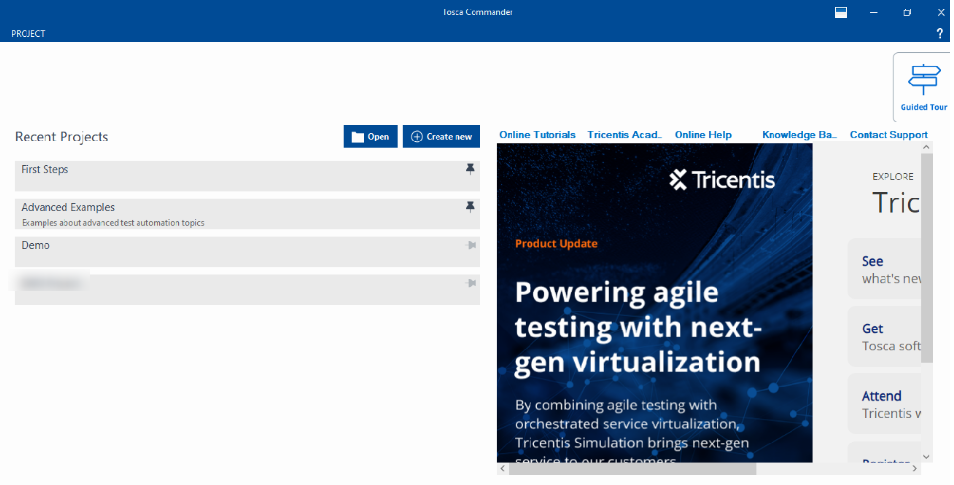
- Click > create new
- In the subsequent Tosca Commander: Create new workspace window, select Oracle, MS SQL Server, or DB2 from the Select type of Repository drop-down menu.
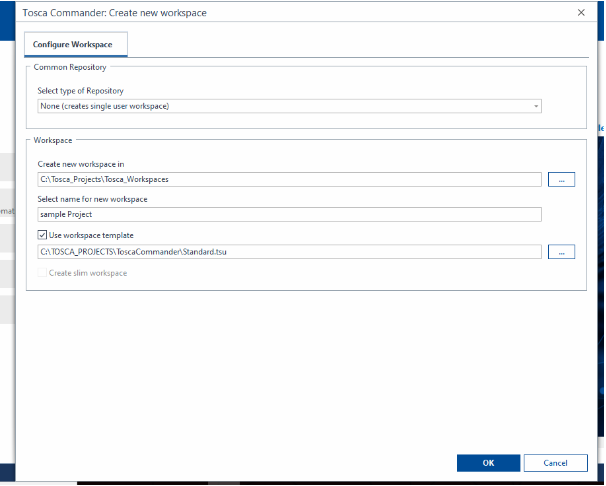
- Click OK to create a new workspace
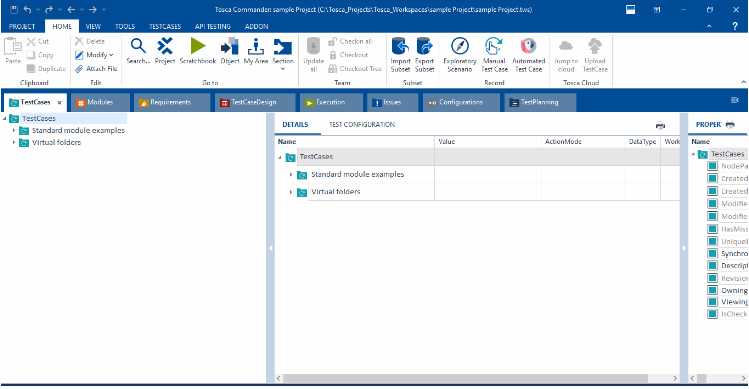
- To view the project structure, click on the Project
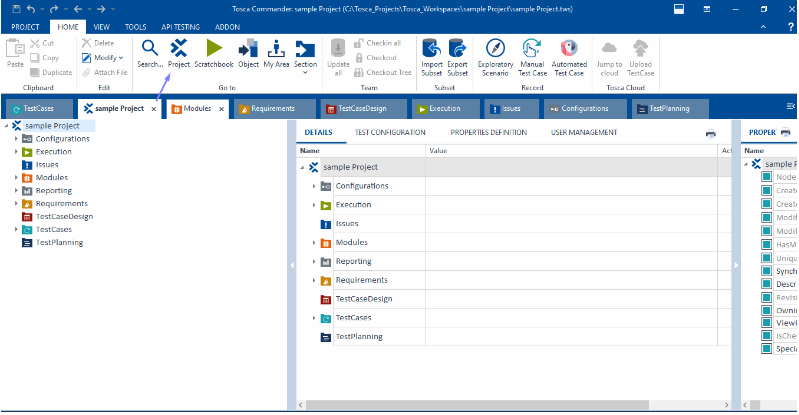
- Configure Project Settings: Set up your workspace. Also, adjust any necessary settings for your project in Tosca, such as database or API connections.
Step 3: Create the Application Model
- Find and Scan Your Application (AUT):
1.Open the Scanner: Tosca has different scanning options based on the application type (web, desktop, or mobile). Launch the scanner through Tosca Commander > Scan Application.
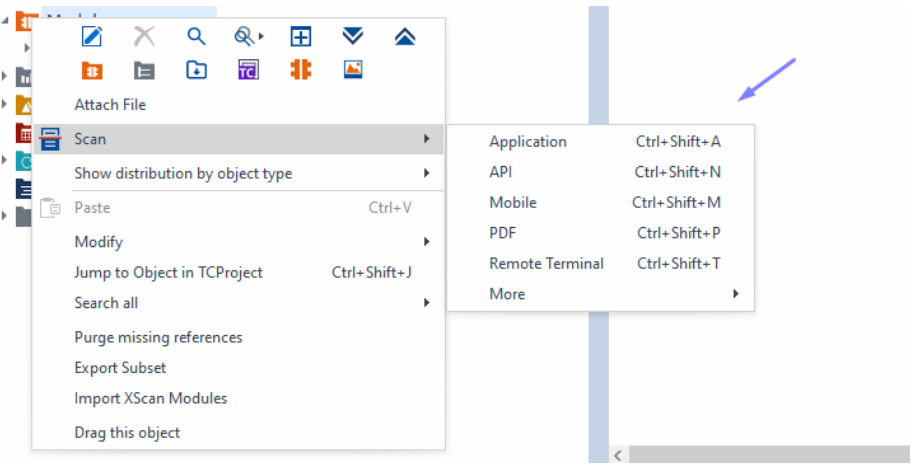
2.Identify Controls: For a web app, for example, open the browser and navigate to the AUT. Select the web scanner, and Tosca will display elements (buttons, input fields, etc.) as you hover over them.
Right click on Modules > scan > Application
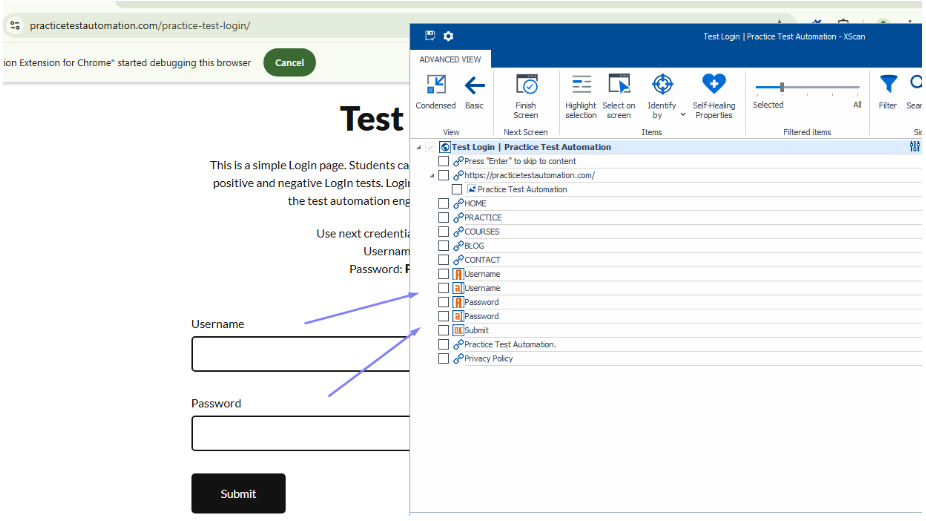
3.Select and Capture: Click to capture relevant elements for testing. Tosca will record these elements in a structured format, enabling them for reuse in different test cases.

- Create Modules: Organize these parts into modules. These modules are the foundation for your test cases.
- Modules: Reusable components in Tosca for parts of an application (e.g., login screen with fields and buttons).
- Sub-Modules: Smaller sections within a Module, used for complex screens with multiple sections (e.g., product details in an e-commerce app).
To create a sub-module (Right click on the module > create folder
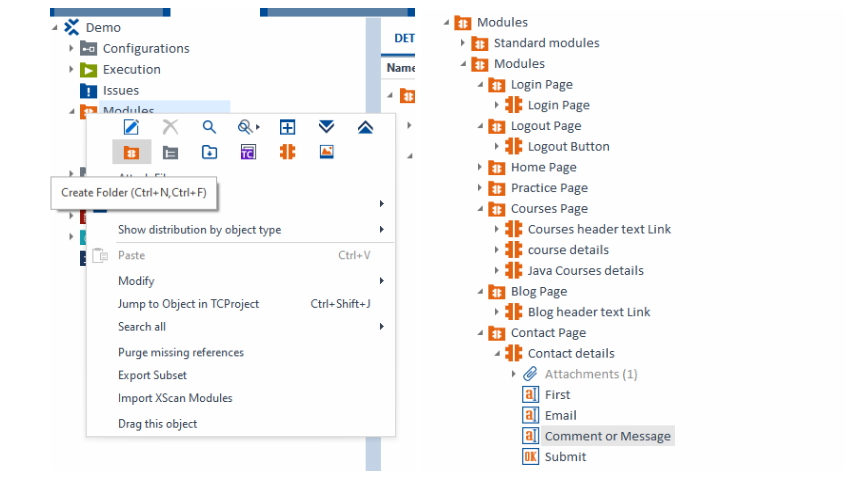
Step 4: Design Test Cases Using the Model
- Define Test Steps: Drag and Drop Elements: In Tosca Commander, start a new test case and drag elements from modules to create test steps. Arrange these steps in the order users typically interact with the application (e.g., navigating to login, entering credentials, and submitting).
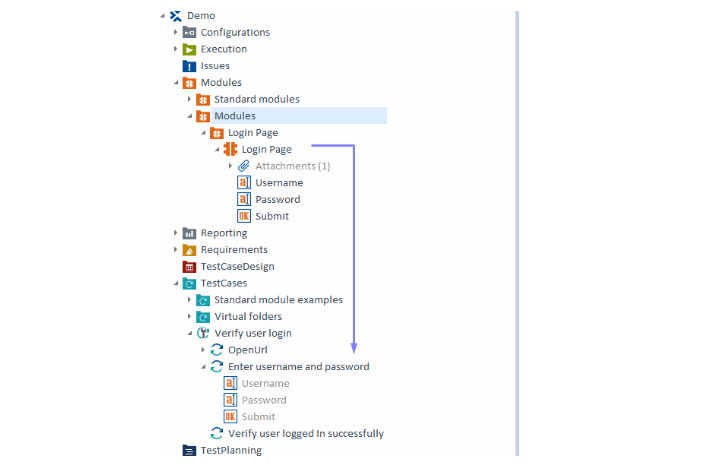
- Specify Actions and Values: For each step, specify actions (click, input text) and values (e.g., “username123” for a login field).
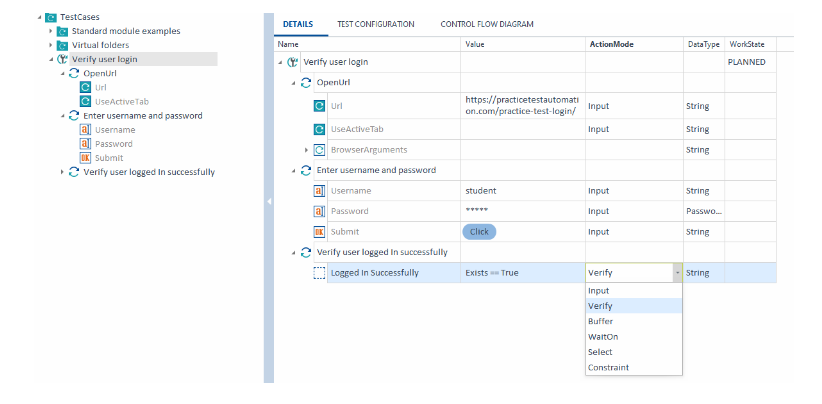
Input (Standard): Enters values into test objects (e.g., text fields, dropdowns).
Verify: Checks if test object values match expected results.
Buffer: Captures and stores data from test objects for later use.
WaitOn: Pauses execution until a specific condition is met on a test object.
Constraint: Defines conditions for filtering or selecting rows in tables.
Select: Selects items or rows in lists, grids, or tables based on criteria.
- Parameterize Test Steps: Include parameters to make tests flexible and based on data. This helps you run tests with various inputs.
Step 1: Create a Test Sheet in Test Case Design
- Go to the Test Case Design section in Tosca.
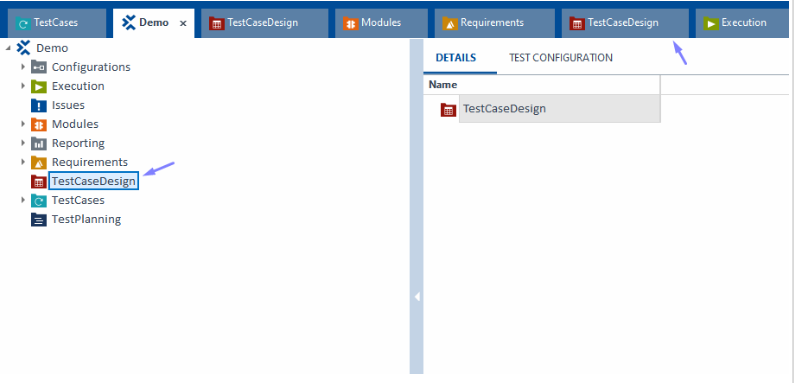
- Create a New Test Sheet: Right-click on the Test Case Design folder and select
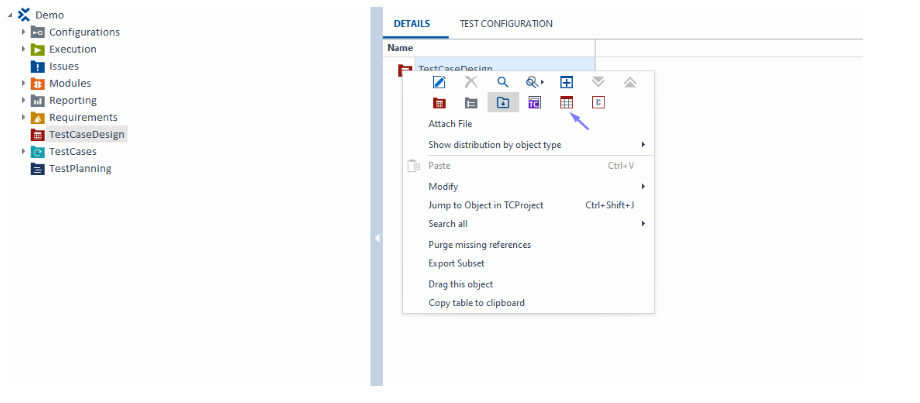
- Create Test Sheet Name your test sheet, e.g., “Environment Test Data.”
-
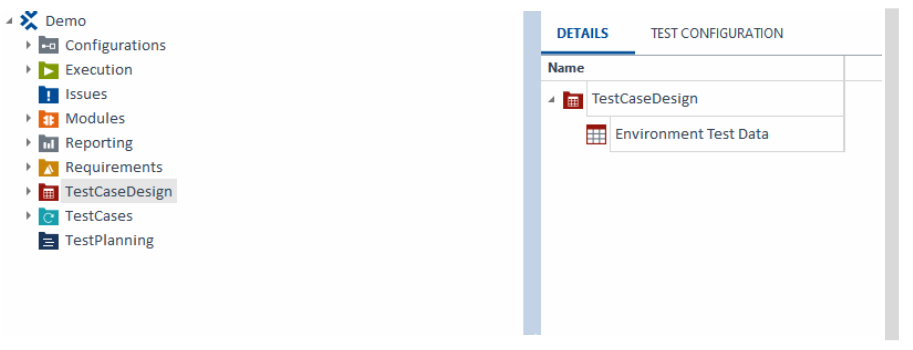
- Add Test Cases/Parameters to the Test Sheet:
- Add rows for the different environments (QA, Prod, and Test) with their respective values.
1.Right click on the sheet > Create Instance
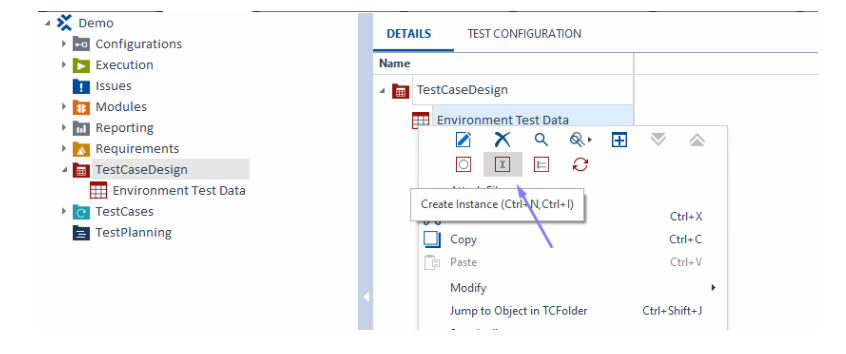
2.Create your own instance e.g., “QA, PROD”
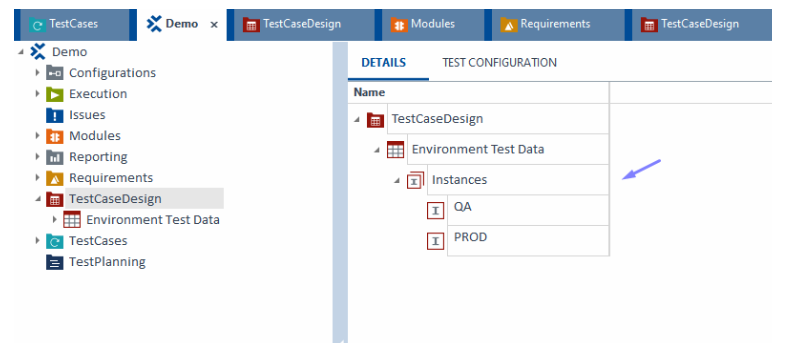
3.Double-click on the sheet for a more detailed instance view.
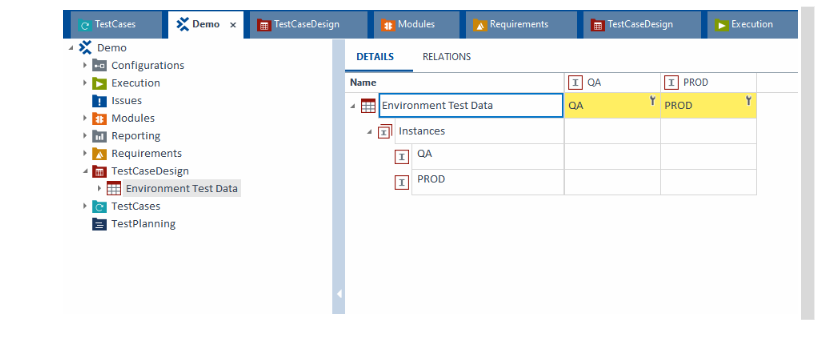
4.Right click on the sheet > Create Attribute
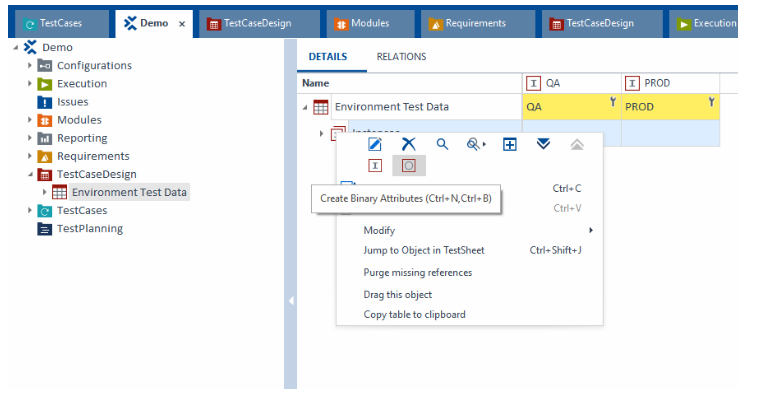
5.Inside the attribute, add parameters (e.g., URL, Username, Password).
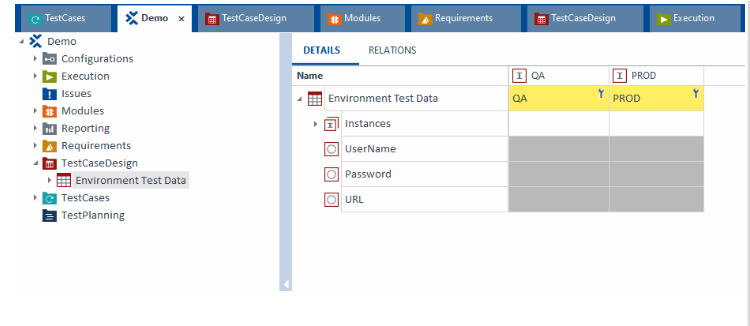
6.For single attributes, we can add multiple instance values [Right click on the attribute > click create instance]
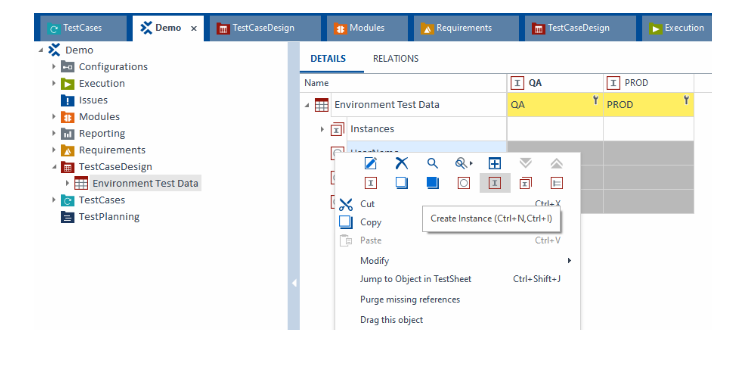
7.We can create a multiple instance (Test data) for single attribute
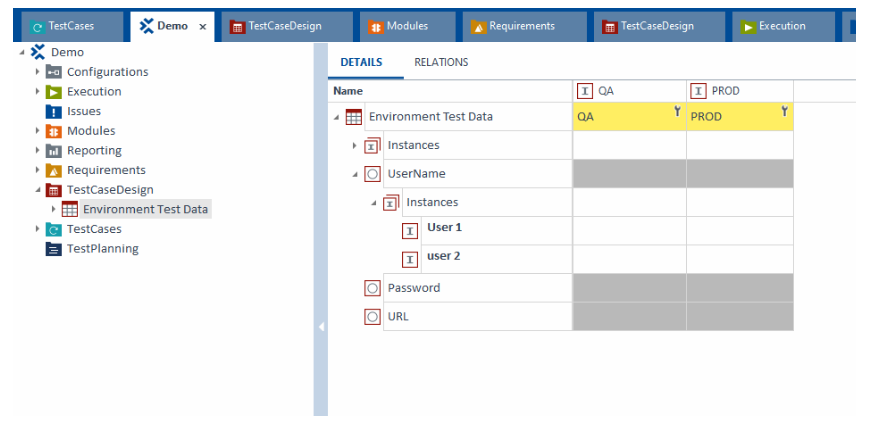
8.And select user 1 or user 2 according to you test case from drop-down
Note: Newly added instance will be displayed under the attribute drop-down
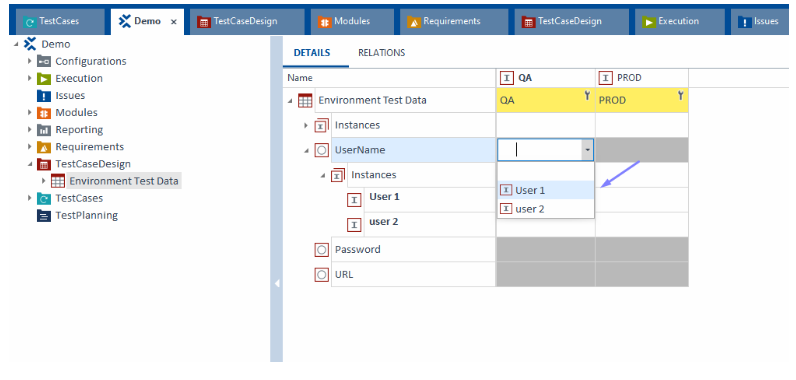
Step 2: Create Buffers and Link to Test Case
- Create Test Case: Open Tosca, right-click the desired folder, choose Create Test Case, and name it has “Buffer”.
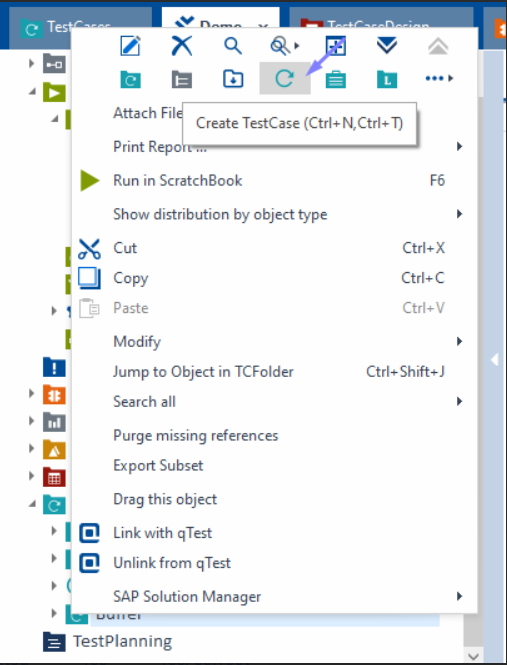
- Add Set Buffer Module: In Modules, locate Standard modules >TBox Automation Tools>Buffer Operations>TBox Set Buffer and drag it into the test case.
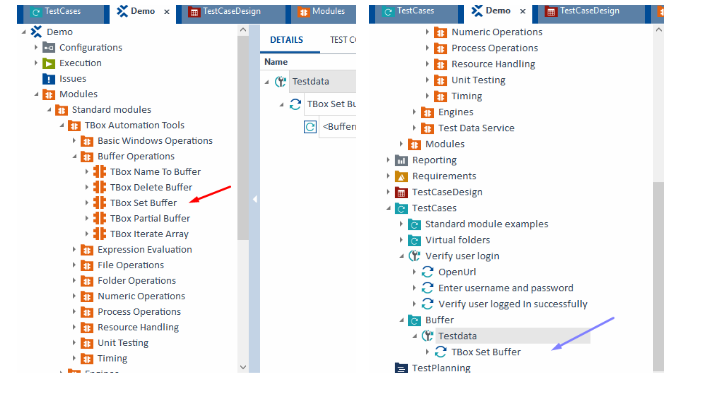
- Convert Test Case to Template: Right-click on the test case, select Convert to Template. This action makes the test case reusable with different data.
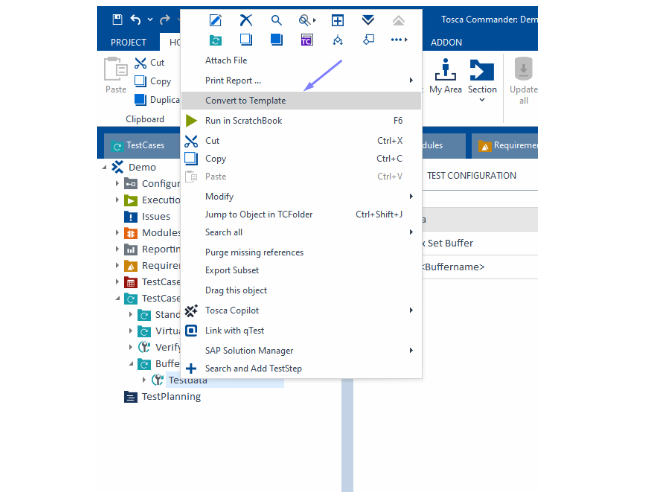
- Drag and drop, to map the test sheet from Test Case Design to the Test Case Template
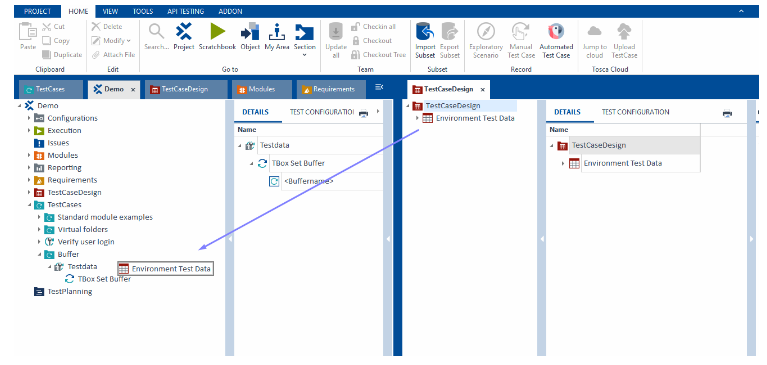
- After mapping the test sheet to the template test case, you can assign the test sheet attributes to buffer values for reuse within the test steps
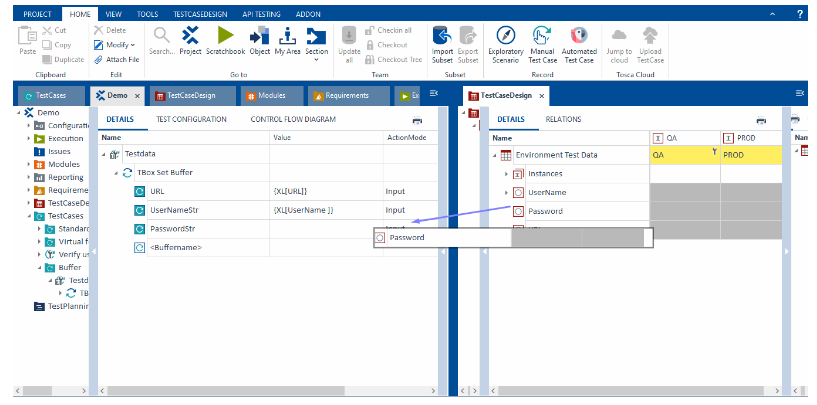
- Now, you can generate template instances for the created instance, Right-click on the Template Test Case and click > Create TemplateInstance.
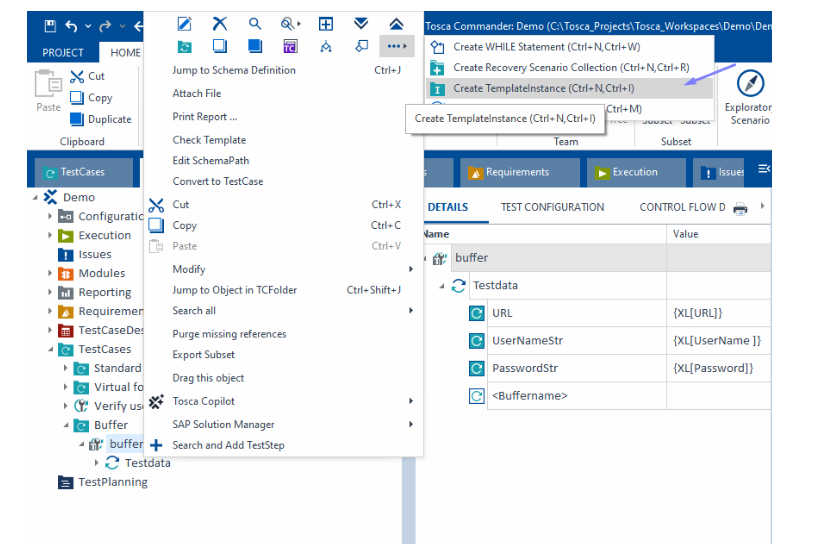
- Tosca will create separate instances under the template test case, each instance populated with data from one row in the test sheet.
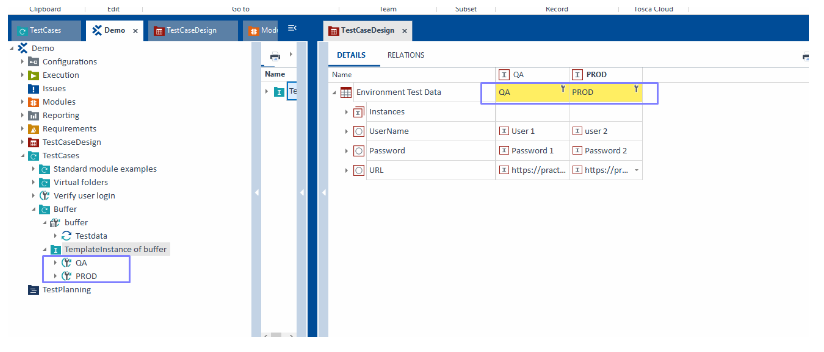
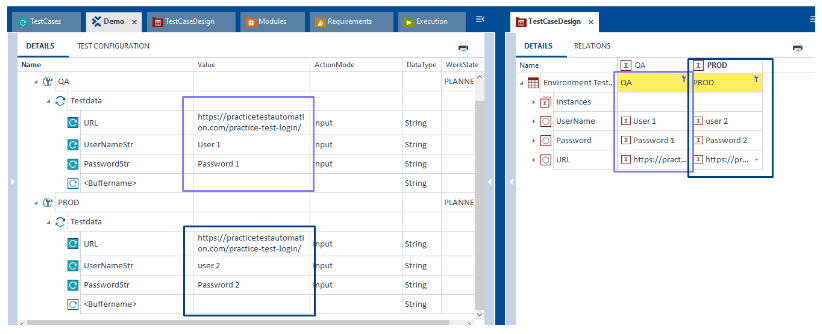
Step 3: Run the Test Case and View Buffer Values in Tosca
Run the test case and view buffer values in Tosca:
- Navigate to the Template Test Case Instances:
-Go to Test Cases in Tosca and locate the instances generated from your template test case.
- Run the Test Case:
-Right-click on an instance (or the template test case itself) and select Run.
-Tosca will execute the test case using the data from the test sheet, which has been mapped to buffers.
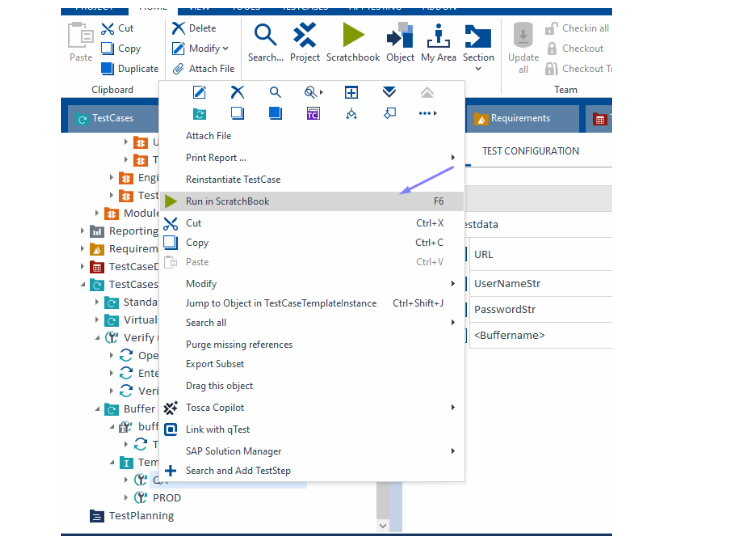
- Check the Execution Log:
-After execution completes, right-click on the instance or test case and select Execution Log.
-In the Execution Log, you’ll see detailed results for each test step. This allows you to confirm that the correct buffer values were applied during each step.
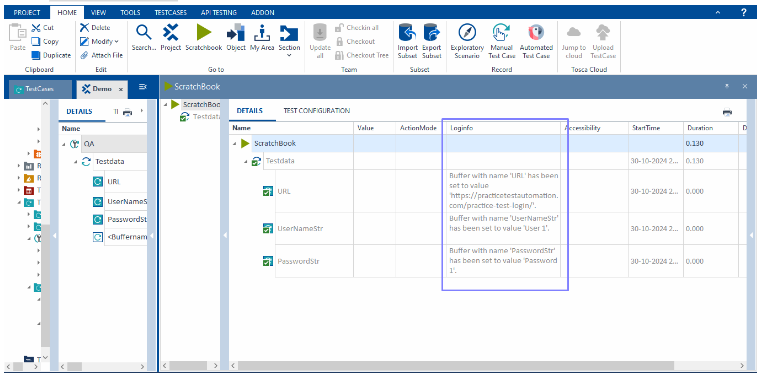
- Open the Buffer Viewer:
-To further inspect the buffer values, open the Buffer Viewer:
-Go to Tools > Buffer (or click on the Buffer Viewer icon in the toolbar).
-The Buffer Viewer will display all buffer values currently stored for the test case, including the values populated from the test sheet.
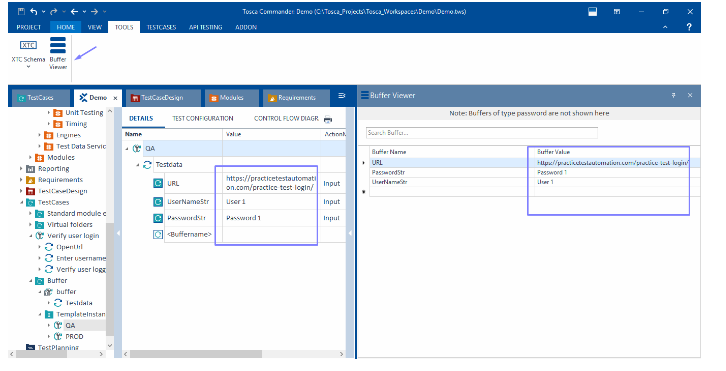
- Verify Buffer Values in Buffer Viewer:
-In the Buffer Viewer, locate and confirm the buffer names (e.g., URL_Buffer, Username_Buffer) and their corresponding values. These should match the values from the test sheet for the executed instance.
-Verify that each buffer holds the correct data based on the test sheet row for the selected instance (e.g., QA, Prod, Test environment data).
- Re-run as Needed:
-If needed, you can re-run other instances to verify that different buffer values are correctly populated for each environment or row.
Step 4: Using Buffers in Test Cases
- In any test step where you want to use a buffered value, type {B[BufferName]} (replace BufferName with the actual name of your buffer).
- For example, if you created a buffer called URL, use {B[URL]} in the relevant test step field to retrieve the buffered URL.
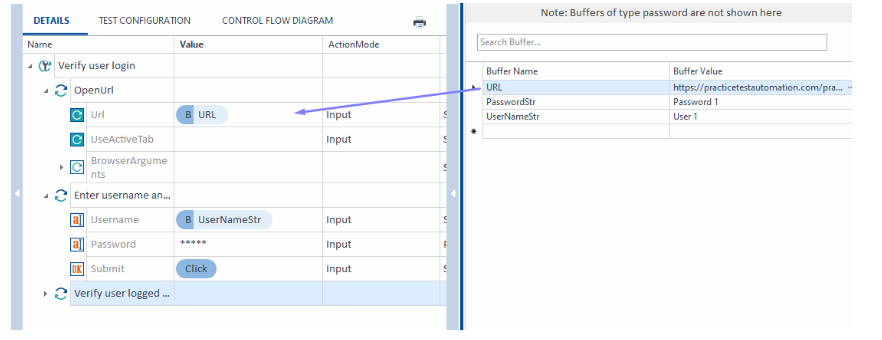
Step 5: Build Reusable Libraries and Test Step Blocks
- Create Libraries: Build libraries or testing steps that can be reused. This saves time and reduces work that needs to be done repeatedly.
- Divide and Organize: Arrange reusable sections so you can use them in various test cases and projects.
Step 6: Execute Test Cases
In Tosca, test cases can be executed in two main ways:
| Feature |
Scratchbook |
Execution List |
| Purpose |
For ad-hoc or quick test runs during development and troubleshooting. |
Designed for formal, repeatable test runs as part of a structured suite. |
| Persistence of Results |
Temporary results; they are discarded once you close Tosca or re-run the test case. |
Persistent results; saved to Tosca’s repository for historical tracking, reporting, and analysis. |
| Control Over Execution |
Limited configuration; runs straightforwardly without detailed settings. |
Detailed execution properties, including priorities, data-driven settings, and environment configurations. |
| Suitability for CI/CD |
Not intended for CI/CD pipelines or automated execution schedules. |
Commonly used in CI/CD environments for systematic, automated testing as part of build pipelines. |
| Scheduling & Reusability |
Suitable for one-off runs; not reusable for scheduled or repeatable tests. |
Can be scheduled and reused across test cycles, providing consistency and repeatability. |
Steps to Execute TestCases in Scratchbook
- Select TestCases/TestSteps in Tosca’s TestCases section.
- Right-click and choose Run in Scratchbook.
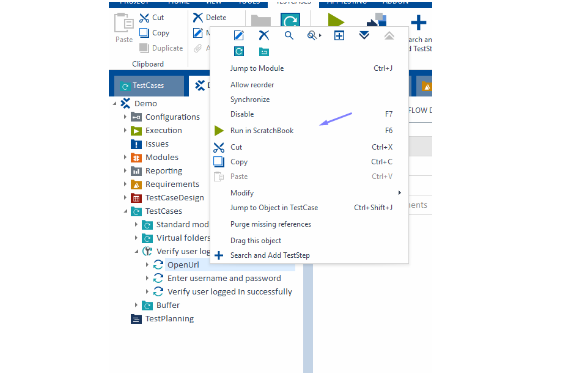
- View Results directly in Scratchbook (pass/fail status and logs).
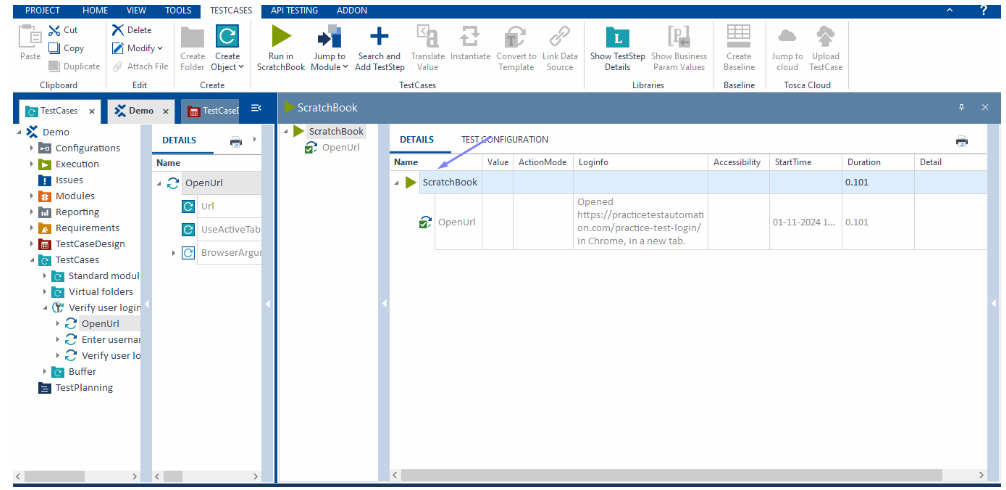
Steps to Set Up an Execution List in Tosca
- Identify the TestCases: Determine the test cases that need to be included based on the testing scope (e.g., manual, automated, API, or UI tests).
- Organize Test Cases in the Test Case Folder: Ensure all required test cases are organized within appropriate folders in the Test Cases section.
- Create an Execution List:
-Go to the Execution section of Tosca.
-Right-click > Create Execution List. Name the list based on your testing context (e.g., “Smoke Suite” or “Regression Suite”).
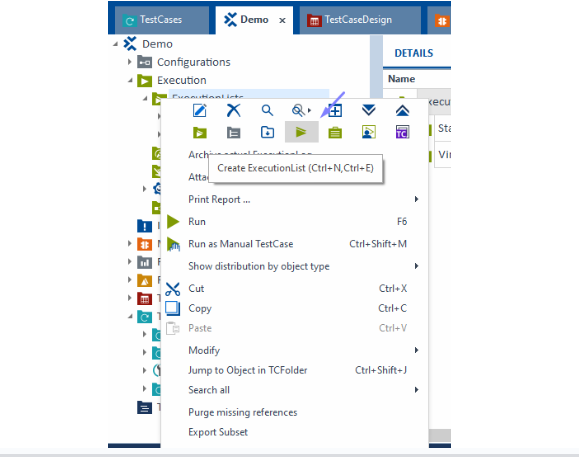
- Drag and Drop Test Cases:
-Navigate back to the TestCases section.
-Drag and drop the test cases (or entire test case folders if you want to include multiple tests) into your execution list in the Execution section.
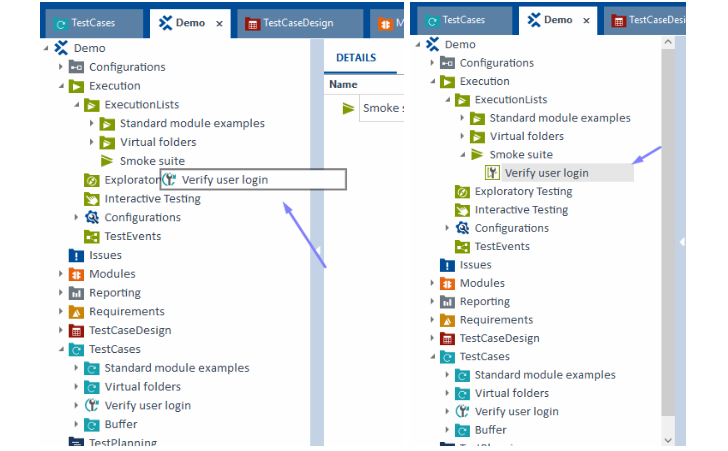
–Save and Execute: Save the execution list, then execute it by right-clicking and selecting Run.
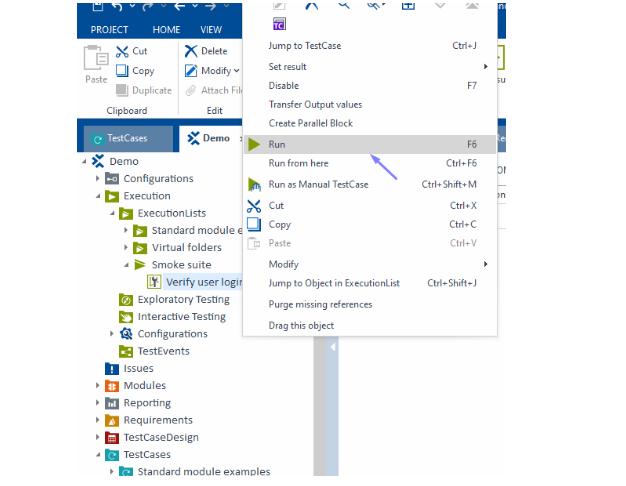
-The execution will start, and progress is shown in real-time.
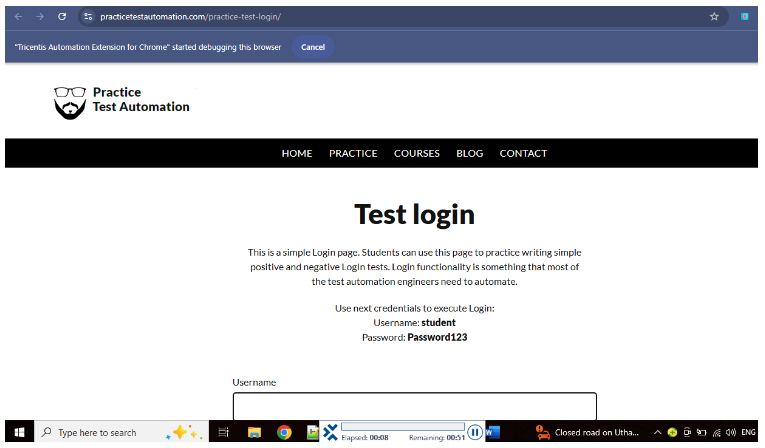
– After execution, you can view the pass/fail status and logs in Execution Results
- Navigate to Execution Results:
-Navigate back to the TestCases section.
-You’ll see each TestCase with a pass (green) or fail (red) status.
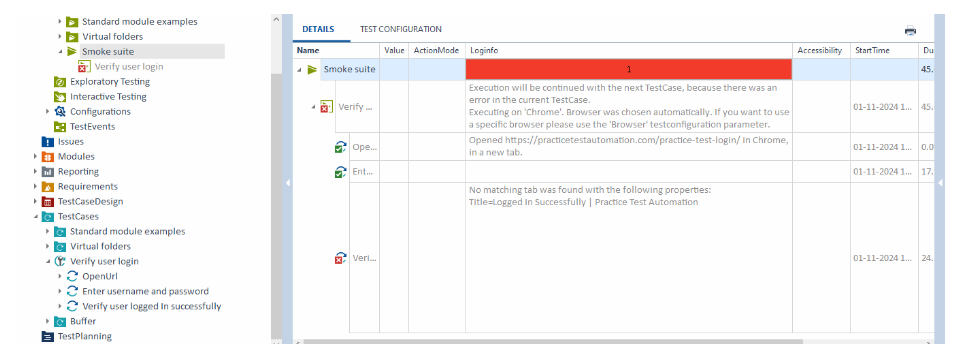
Step 7: Review and Validate Test Results
- Generate Reports:
-After execution, go to Execution Results.
-Right-click to print reports in various formats (Excel, PDF, HTML, etc.) based on your requirements.
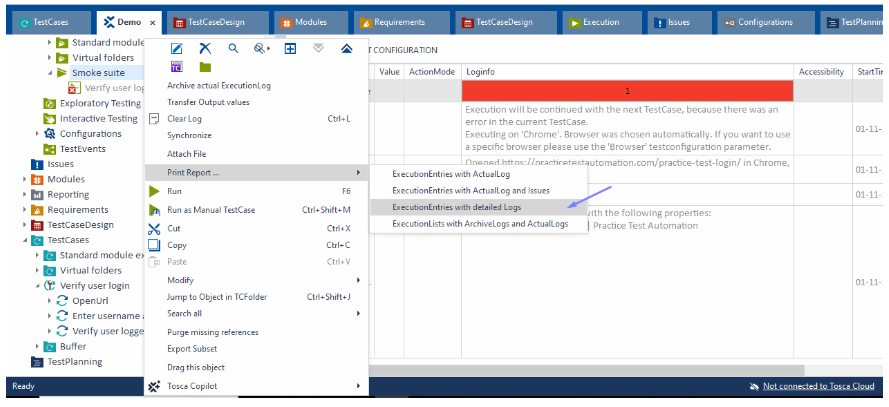
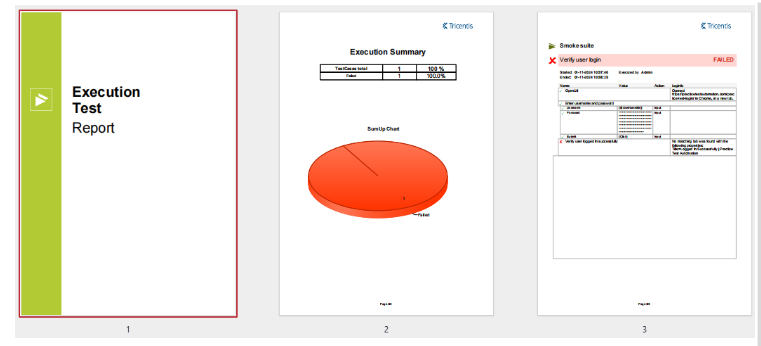
- Check Results: Use Tosca’s reporting tools to look at the test execution results. See if there are any issues.
- Record and Document Findings: Write down everything you find. This includes whether the tests pass or fail and any error details.
Step 8: Maintain and Update Models and Test Cases
- Get used to changes: Update your sections and test cases as your application grows. Make changes directly in the model.
- Make it easy to reuse: Keep improving your parts and libraries. This will help them remain usable and function well.
Benefits of using the Model-Based Approach in Tosca Automation
The benefits of using Tosca’s model-based approach are many. First, it greatly speeds up test automation. A major reason for this is reusability. When you create a module, you can use it for several test cases. This saves time and effort when making tests.
One big benefit is better software quality. A model-based approach helps teams build stronger and more complete Tosca test suites. The model provides a clear source of information. This allows the test cases to show how the application works correctly. It also helps find mistakes that may be missed otherwise.
Comparison of the Model-Based Approach with traditional methods of Tosca Automation
When you look at the model-based approach and compare it to the old Tosca automation methods, the benefits are clear. Traditional testing requires scripts. This means it takes a long time to create test suites. It is also hard to maintain them. As applications become more complex, this problem gets worse.
The model-based approach helps teams be flexible and quick. It allows them to adapt to changes smoothly. This is key for keeping up with the fast pace of software development. The back-and-forth process works well with modern development methods like Agile and DevOps.
Real-world examples of successful implementation of the Model-Based Approach in Tosca Automation
Many companies from different industries have had great success with Tosca’s model-based approach for automation. These real examples show the true benefits of this method in different environments and various applications.
| Industry |
Organization |
Benefits |
| Finance |
Leading Investment Bank |
Reduced testing time by 50%, Improved defect detection rates |
| Healthcare |
Global Healthcare Provider |
Accelerated time-to-market for critical healthcare applications |
| Retail |
E-commerce Giant |
Enhanced online shopping experience with improved application stability |
Conclusion
In conclusion, using the Model-Based Approach in Tosca Automation can really help with your testing. This method makes it easier to find objects and allows you to create reusable test libraries. With this approach, you will check your work and test more effectively. Following this method can lead to better efficiency and higher productivity in automation. Model-based testing with Tosca helps you design and run tests in a smart way. By trying this new approach, you can improve your automation skills and keep up in the fast-changing world of software testing. Companies like Codoid are continually innovating and delivering even better testing solutions, leveraging tools like Tosca to enhance automation efficiency and results. Check out the benefits and real examples to see what Tosca Automation offers with the Model-Based Approach.
Frequently Asked Questions
-
What Makes Tosca’s Model-Based Approach Unique?
Tricentis Tosca uses a model-based way to work. This helps teams get results quicker. It offers simple visual modeling. Test setup is easy and does not need scripts. Its powerful object recognition makes test automation easy. Because of this, anyone, whether they are technical or not, can use Tosca without problems.
-
How Does Tosca Automation Integrate with Agile and DevOps?
Tosca works well with agile and DevOps methods. It supports continuous testing and works nicely with popular CI/CD tools. This makes the software development process easier. It also helps teams get feedback faster.
-
Can Tosca Automation Support Continuous Testing?
Tosca Automation is an excellent software testing tool. It is designed for continuous testing. This tool allows tests to run automatically. It works perfectly with CI/CD pipelines. Additionally, it provides fast feedback for continuous integration.
-
What Resources Are Available for Tosca Automation Learners?
Tosca Automation learners can use many resources. These resources come from Tricentis Academy. You will find detailed documents, community forums, and webinars. This information supports Tosca test automation and shares best practices.

by Chris Adams | Oct 30, 2024 | Software Development, Blog, Latest Post |
In web development, creating apps that are dynamic and use a lot of data needs a good tech stack. Node.js and MongoDB are great choices for this, especially in a Linux setting. Node.js is a flexible place for JavaScript. It helps developers build servers and applications that can grow easily. MongoDB is a popular NoSQL database. It’s perfect for storing documents that look like JSON. Working together, Node.js and MongoDB form a strong pair for building modern web applications.
Key Highlights
- Node.js and MongoDB work well together to build modern applications that use a lot of data.
- The flexible way MongoDB stores data and Node.js’s ability to handle multiple tasks at once make them great for real-time apps.
- It’s easy to set up a Node.js and MongoDB environment using tools like npm and the official MongoDB driver.
- Mongoose helps you work with MongoDB easily. It gives you schemas, validation, and a simple API for actions like creating, reading, updating, and deleting data.
- Security is very important. Always make sure to clean user input, use strong passwords, and think about using database services like MongoDB Atlas.
Essential Steps for Integrating Node.js with MongoDB
Integrating Node.js with MongoDB might feel hard at first, but it becomes simpler with a good plan. This guide will help you understand the basic steps to connect these two tools in your development work. With easy instructions and practical examples, you will quickly find out how to link your Node.js app to a MongoDB database for use in a browser.
We will cover each step from setting up your development environment to performing CRUD (Create, Read, Update, Delete) operations. By the end of this guide, you will know the important details and feel ready to build your own Node.js applications using the strength and flexibility of MongoDB.
1. Set Up Your Environment
- Install Node.js: You can download and install it from the Node.js official site.
- Install MongoDB: You can set up MongoDB on your computer or go for a cloud service like MongoDB Atlas.
2. Initialize Your Node.js Project
Make a project folder, go to it, and run:
Install the needed packages. Use mongoose for working with MongoDB. Use express to build a web server.
npm install mongoose express
3. Connect to MongoDB
Create a new file (like server.js) and set up Mongoose to connect to MongoDB.
const mongoose = require('mongoose');
mongoose.connect('mongodb://localhost:27017/yourDatabaseName', {
useNewUrlParser: true,
useUnifiedTopology: true
})
.then(() => console.log('Connected to MongoDB'))
.catch(err => console.error('Connection error', err));
4. Define a Schema and Model
Use Mongoose to create a schema that shows your data structure:
const userSchema = new mongoose.Schema({
name: String,
email: String,
age: Number
});
const User = mongoose.model('User', userSchema);
5. Set Up Express Server and Routes
Use Express to build a simple REST API that works with MongoDB data.
const express = require('express');
const app = express();
app.use(express.json());
// Create a new user
app.post('/users', async (req, res) => {
try {
const user = new User(req.body);
await user.save();
res.status(201).send(user);
} catch (err) {
res.status(400).send(err);
}
});
// Retrieve all users
app.get('/users', async (req, res) => {
try {
const users = await User.find();
res.send(users);
} catch (err) {
res.status(500).send(err);
}
});
const port = 3000;
app.listen(port, () => console.log(`Server running on http://localhost:${port}`));
6. Token Authorization
JWT token
const jwt = require('jsonwebtoken');
const JWT_SECRET = 'sample'; // Replace with your actual secret key, preferably from an environment variable
function authenticateToken(req, res, next) {
const authHeader = req.headers['authorization'];
const token = authHeader && authHeader.split(' ')[1];
if (token == null) return res.sendStatus(401); // If there's no token
jwt.verify(token, JWT_SECRET, (err, user) => {
if (err) return res.sendStatus(403); // If the token is no longer valid
req.user = user;
next(); // Pass the execution to the next middleware function
});
}
module.exports = authenticateToken;
7. Establishing MongoDB Connections
- Install – MongoDb Compass
- Establish conection using defaul host in compass – mongodb://localhost:27017
- Data will be listed as row.
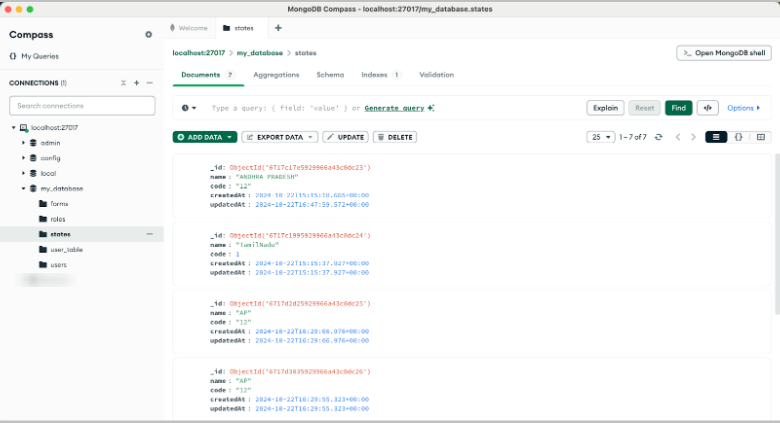
8. Test the Integration
Start the server:
Use a tool like Postman to check your API. You can do this by sending POST and GET requests to http://localhost:3000/users.
8. Performing CRUD Operations with Mongoose
Mongoose makes it simple to work with databases and set up routing. First, define a schema for your data. For example, a ‘Student’ schema could include details like name (String), age (Number), and grade (String). Mongoose provides a simple API for CRUD tasks.
- To create documents, use Student.create().
- To read them, use Student.find().
- To update a document, use Student.findOneAndUpdate().
- For deleting, use Student.findByIdAndDelete().
You will work with JSON objects that show your data. This helps in using MongoDB easily in your Node.js app, especially when you connect a router for different actions.
9. Enhancing Node.js and MongoDB Security
Security is very important. Never put sensitive data, like passwords, right in your code. Instead, use environment variables or configuration files. When you query your MongoDB database in Node.js, make sure to clean up user inputs to prevent injection attacks. Consider using managed database services like MongoDB Atlas. These services provide built-in security features, backups, and growth options. If you host your app on platforms like AWS, use their security groups and IAM roles to control access to your MongoDB instance.
10. Debugging Common Integration Issues
Encountering problems is normal when you are developing. Use console.log() frequently to check your variables and see how your Node.js code runs. Also, check your MongoDB connection URL for any spelling errors, especially with DNS issues. Ensure that the hostname, port, and database name are correct. When you face challenges, read the official documentation or visit community sites like Stack Overflow and GitHub. If you are working with an MVC framework like Express.js, make sure to check your routes so they match your planned API endpoints.
Conclusion
Node.js and MongoDB are a great match for building powerful applications, enabling efficient data management and seamless scalability. In this blog, you’ll find easy steps to connect to your data and work with it effectively. To get started, familiarize yourself with MongoDB basics, then make sure to secure your application properly. It’s also crucial to address common issues that may arise and follow best practices to keep your app secure and scalable.
To make the most of these technologies, consider partnering with Codoid, known for providing top-tier software development and testing services. Codoid’s expertise in test automation and quality assurance can help ensure your application runs smoothly and meets high standards of performance and reliability. By combining Node.js, MongoDB, and Codoid’s professional support, you’ll be well-equipped to build robust, user-friendly applications that can handle large user bases.
Sharpen your skills by exploring more resources on Node.js and MongoDB, and let Codoid help you bring your project to the next level with their best-in-class software development services. Start your journey today to unlock the full potential of these powerful technologies in your work!
Frequently Asked Questions
-
How do I start with Node.js and MongoDB integration?
Start by installing Node.js and npm. Check the official documentation for clear instructions and tutorials. Use npm to install the 'mongodb' package. This package gives you the Node.js driver for MongoDB. You should also learn about JSON. It is the standard data format used with MongoDB.
-
What are some best practices for securing my Node.js and MongoDB app?
-Put security first.
-Do not hardcode important data.
-Use environment variables instead.
-Use parameterized queries or ORM tools to prevent injection attacks.
-Consider managed database services like MongoDB Atlas.
-Check out cloud options like AWS.
-These can give you better security for NoSQL databases.
-
Can Node.js and MongoDB handle high traffic applications?
Node.js and MongoDB are great for handling busy applications. They perform well and can grow easily with demand. Their non-blocking I/O operations allow them to do several tasks at the same time. Plus, their flexible data models help manage heavy workloads effectively. Combined, they provide a solid solution for tough challenges.
-
Where can I find more resources to learn about Node.js and MongoDB?
You have many resources to help you! Look at the official documentation for Node.js and MongoDB. These guides give you a lot of details. There are online tutorials and courses that focus on specific topics too. You can check open-source projects on GitHub to learn from real apps. Don't forget to explore the Mongoose ODM library. It has an easy API for using MongoDB with Node.js.


